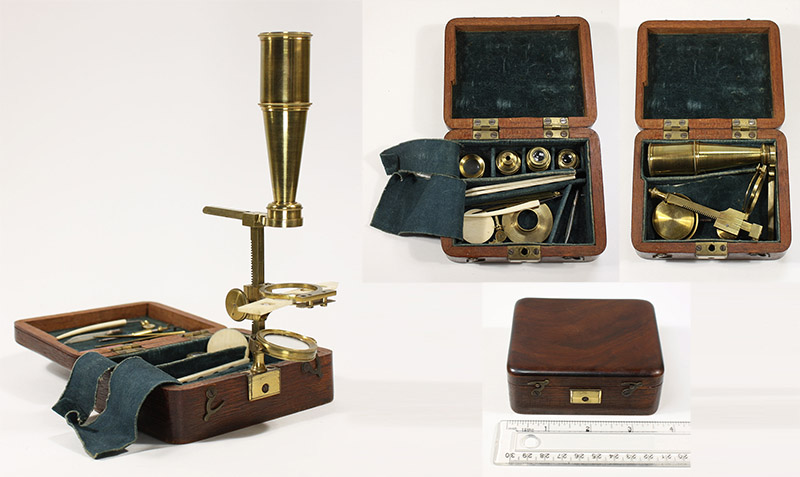
Figure 1A. A ca. 1828 example of the original, small, box-mounted microscope designed by Charles Gould. It stands about 6 1/2 inches / 16 cm tall.
The Cary-Gould-Porter optical businesses
William Cary, 1759 - 1825
John Cary, 1754 - 1835
George Cary, ca. 1788 - 1859
John Cary, Jr., 1791 - 1852
Charles Gould, ca. 1786 - 1849
Henry Gould, ca. 1796 - 1856
Charlotte Hyde Gould, ca. 1797 - 1865
Henry Porter, ca. 1832 - 1902
by Brian Stevenson
last updated October, 2024
The names of Cary, Gould and Porter are intertwined in microscopy, a succession of apprentices and/or relatives who maintained a London microscope-making business for well over 100 years. For the historian, the two centuries that have elapsed between the beginnings of the Cary company have brought many inaccuracies into the record, both in print and on the internet. For example, many sources report that William Cary died in 1835, rather than 1825. Those may have been attempts to reconcile William’s lifespan with the famous microscopes that bore his name, which became popular in the mid-1820s. The Billings Microscope Collection catalogue erroneously states that William Cary was succeeded by Charles Gould under the name of Gould and Porter. Another inaccuracy was an intentional misrepresentation for advertising, in which Henry Porter claimed that he learned his trade with William Cary. Porter was actually born 7 years after Cary’s death.
By far, the most common inaccuracy is the assertion that Charles Gould was William Cary’s apprentice when he invented the famous “Cary” (or “Cary-Gould”) box-mounted portable microscope. While Gould was quite likely Cary’s apprentice at some point, Gould was a master craftsman and well into his 30s when that microscope was first produced. Charles managed the business after Cary died in 1825, and appears to have held that position even before Cary’s death. A large number of contemporary sources described microscopes produced at the Cary shop to be Gould’s inventions. Indeed, Cary died a year before the 1826 debut of the microscope that made him famous.
Three examples of Charles Gould’s box-mounted microscope are shown in Figures 1 and 2. Additional pictures of microscopes, accessories, other scientific instruments, etc. that are associated with Cary, Gould, and related makers are shown throughout this essay.

Figure 1A.
A ca. 1828 example of the original, small, box-mounted microscope designed by Charles Gould. It stands about 6 1/2 inches / 16 cm tall.
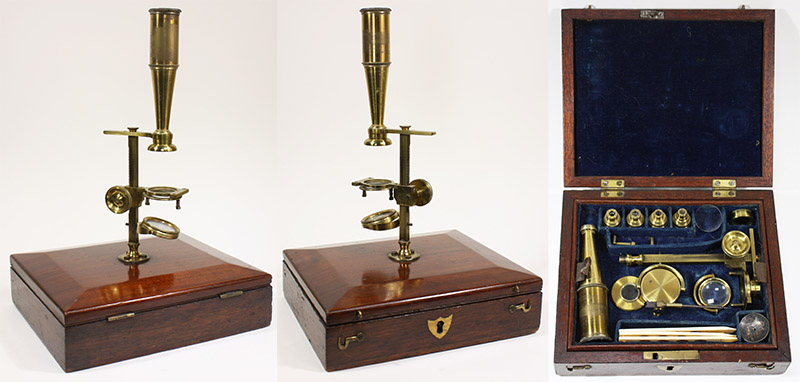
Figure 1B.
A ca. 1830s example of Cary’s larger, “Second Size” microscope. It stands about 10 inches / 23 cm tall.
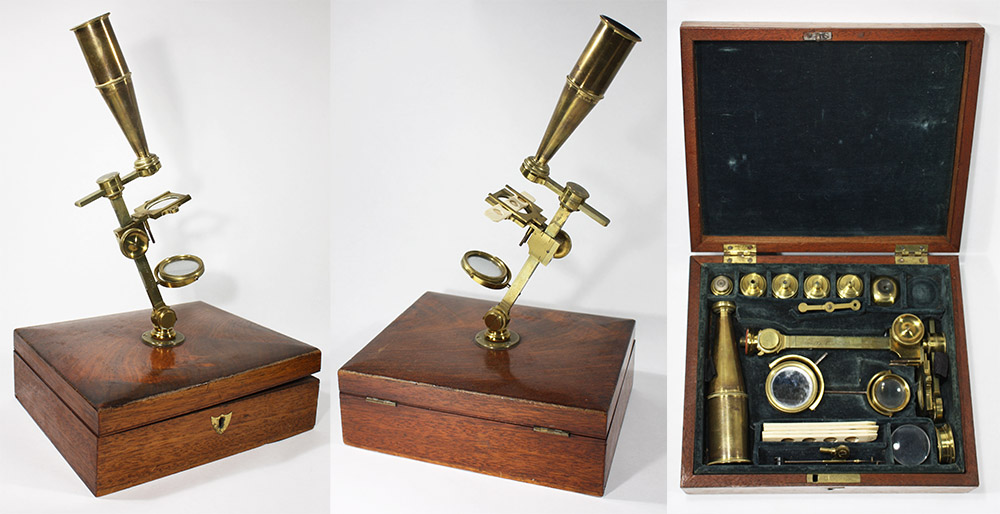
Figure 1C.
Cary’s largest, “Third Size” microscope, ca. 1830s. It stands about 13 1/2 inches / 34 cm tall.

Figure 2.
Cary’s First, Second, and Third Size case-mounted microscopes, as also shown in the above Figures.

Figure 2A.
A version of Cary’s Third Size case-mounted microscope, with rack-and-pinion adjustment on the limb to afford easy aquatic movement. Adapted for nonprofit, educational purposes from an internet auction site.
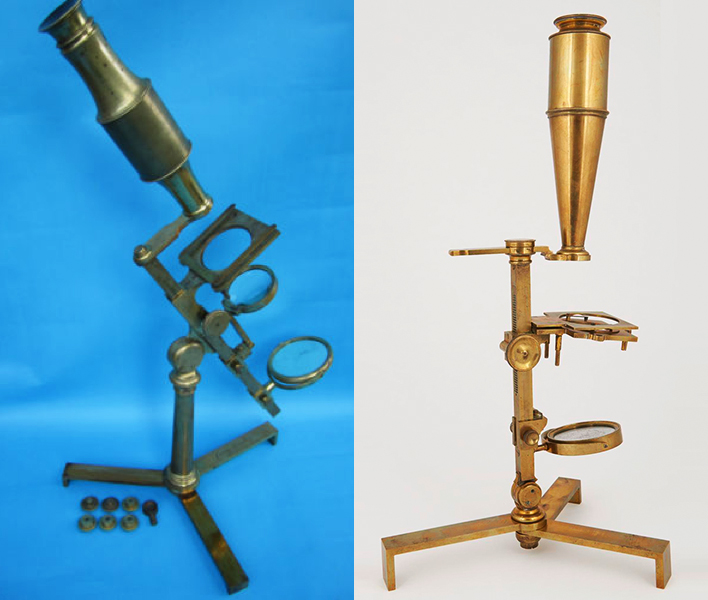
Figure 3A.
Two early types of microscope from the W. Cary shop, probably circa 1800 - 1820. The left microscope is a variant of the "Jones Most Improved" form. The microscope on the right is a variant of Benjamin Martin's "Universal" form. Image adapted for nonprofit, educational purposes from an internet auction site (left) and https://collection.sciencemuseumgroup.org.uk/objects/co119314/compound-monocular-microscope-by-cary-london-mid-compound-monocular-microscopes (right).
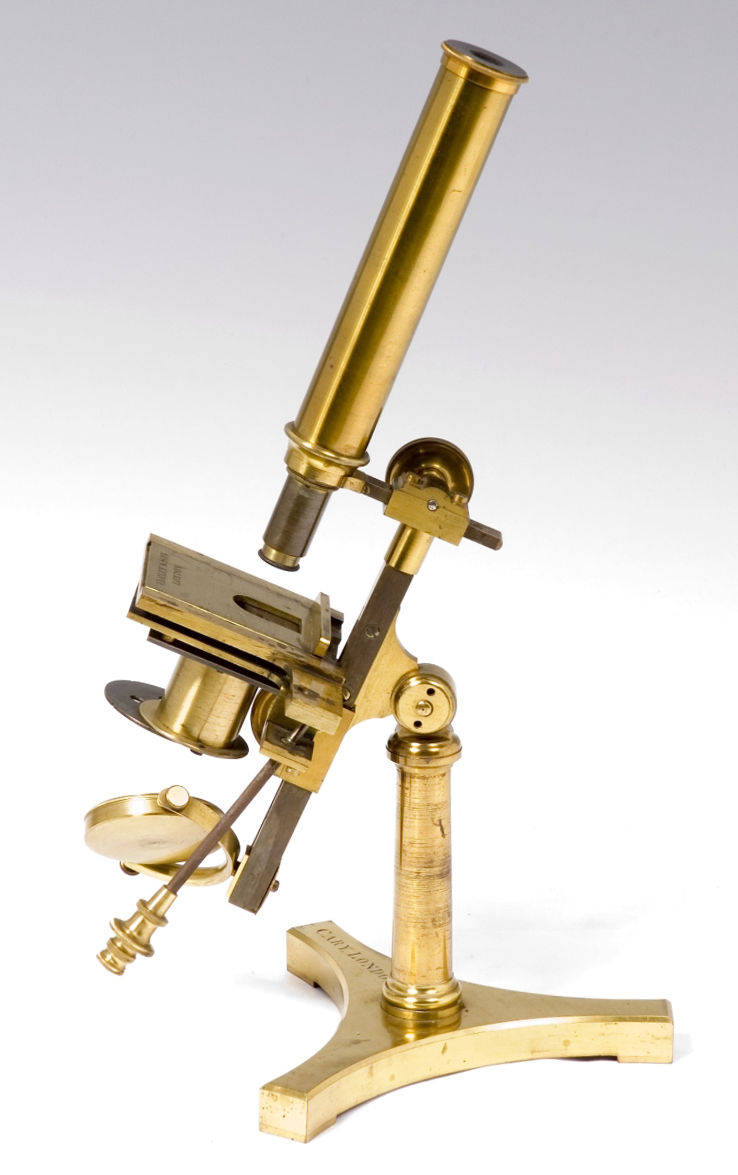
Figure 3B.
Simplified, small variation on the "Jones' Most Improved" pattern, circa 1820-1830. This instrument features a ring of objective lenses similar to those frequently found on microscopes by Dollond, but rarely on those of other makers, suggesting that this example may have be acquired by Cary from Dollond on the wholesale market. Adapted for nonprofit, educational purposes from an internet sale site.
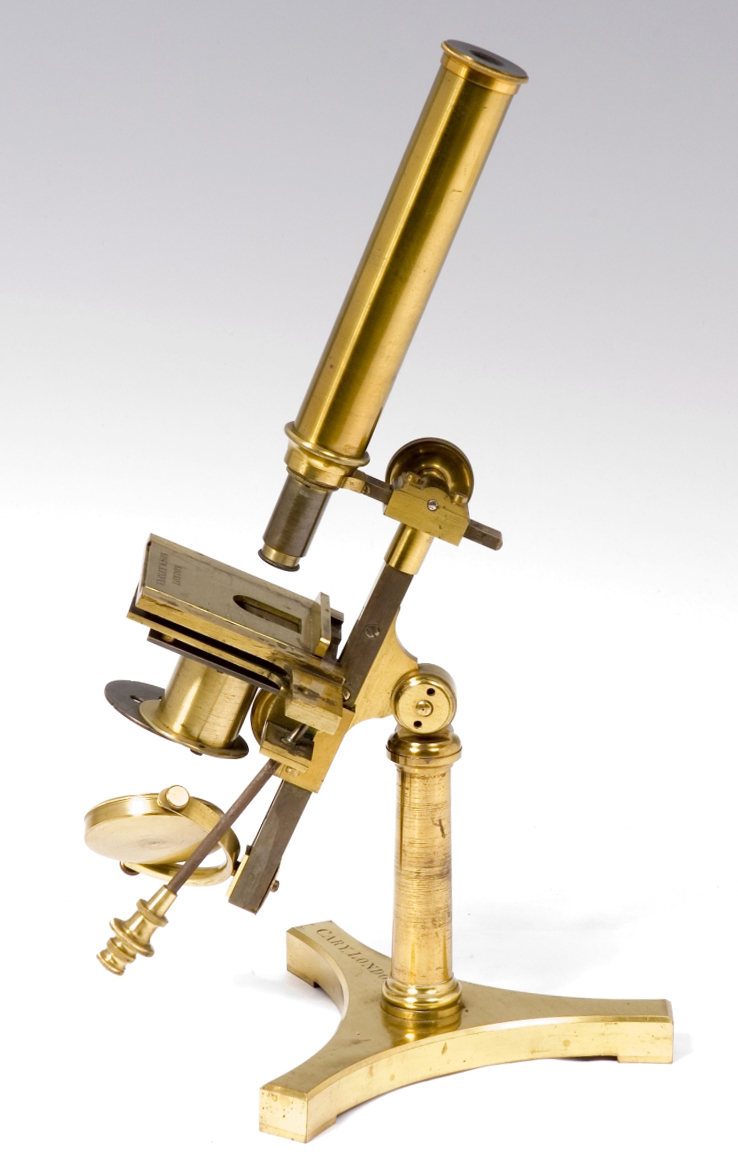
Figure 3C.
Circa 1820-1840 Cary microscope. This instrument has a mechanical stage that was made by Varley and Son, London, a partnership that ran from 1848-1854. The stage was most likely added after purchase. Adapted from The Museum of the History of Science, https://www.mhs.ox.ac.uk/collections/imu-search-page/record-details/?TitInventoryNo=28869
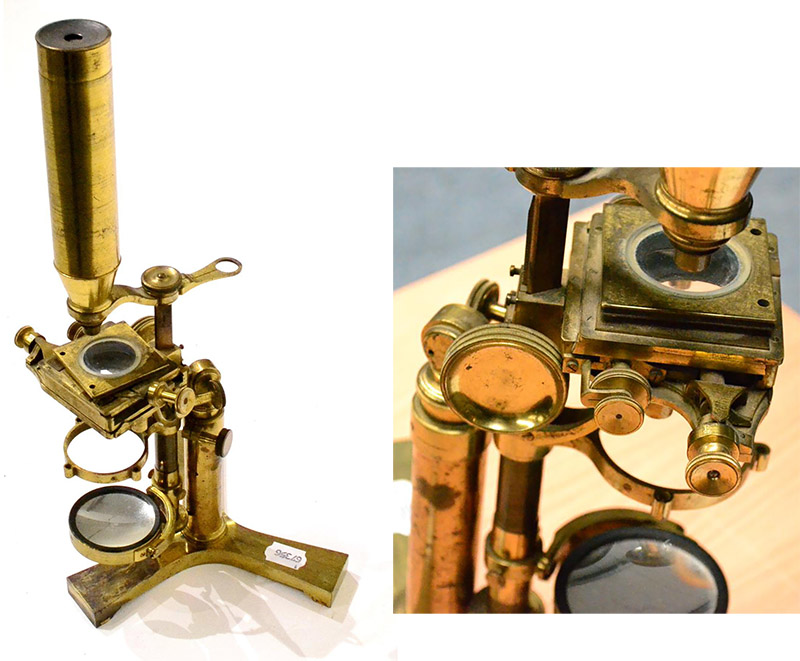
Figure 3D.
Cary microscope, reminiscent of Andrew Pritchard's ca. 1820-1850 patterns. It contains a later model of Gould's adjusting stage, with horizontal adjusting knobs. Adapted for nonprofit, educational purposes from an internet auction site.
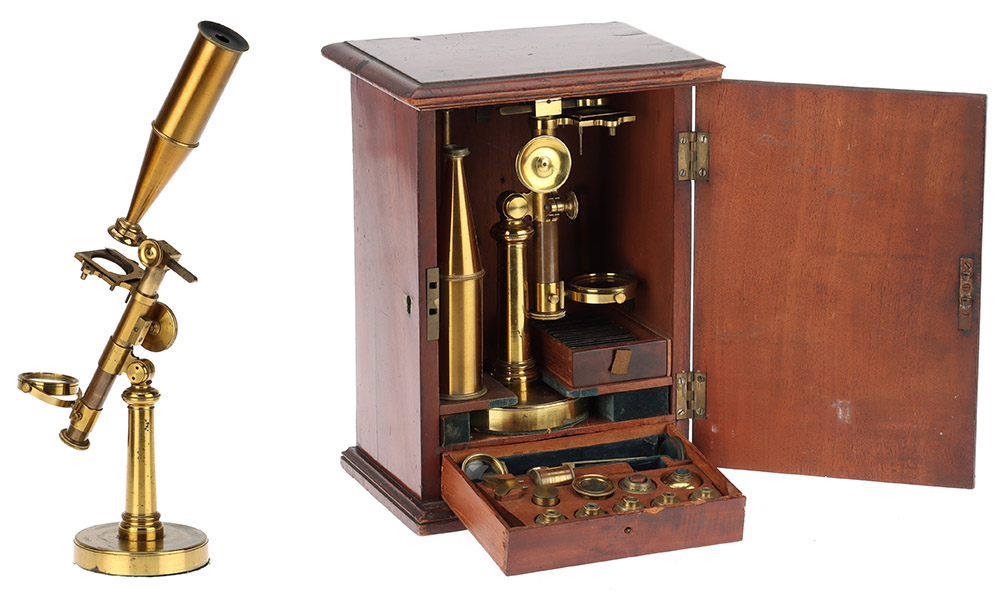
Figure 3E.
Circa 1830s Cary microscope. Adapted for nonprofit, educational purposes from an internet auction site.

Figure 3F.
An unusual form of microscope by Cary, with a Gould's adjusting stage that was invented in 1829. Adapted, with permission, from http://www.microscope-antiques.com/carymech.html

Figure 3G.
Another unique style of microscope by Cary, probably manufactured ca. 1830. Adapted for nonprofit, educational purposes from https://mhs.web.ox.ac.uk/collections-online#/item/hsm-catalogue-6704.

Figure 3H.
A bar limb / “Society of Arts” -style microscope. The base is engraved “Cary”, and so likely dates from before Charlotte Gould and Henry Porter renamed the business ca. 1859.
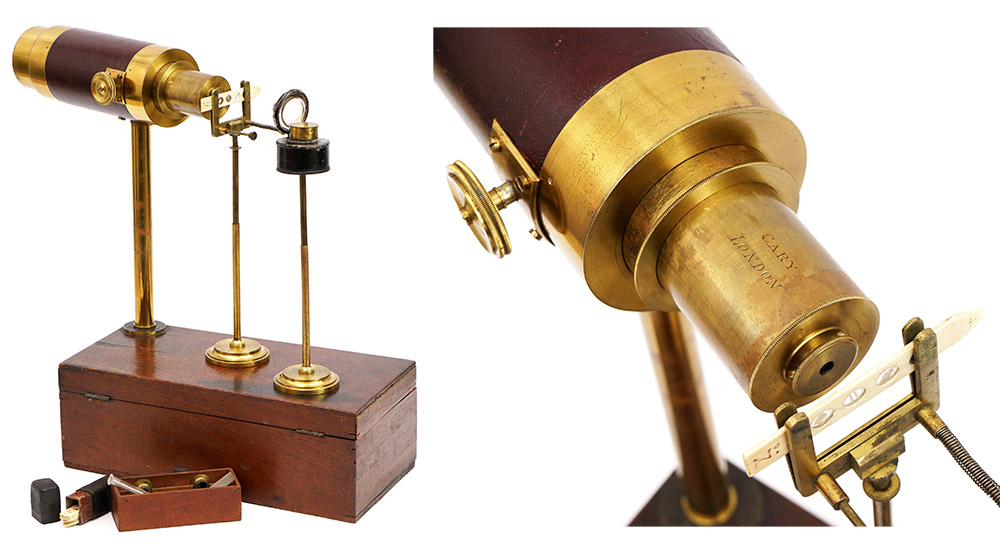
Figure 3I.
A lucernal microscope by Cary, of undermined age. Adapted for nonprofit, educational purposes from an internet auction site.
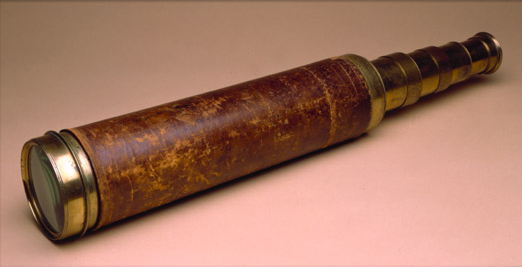
Figure 4.
A telescope produced by W. Cary, that was owned by
American explorer Meriwether Lewis (1774-1809). Image from
http://www.lewisandclarkexhibit.org/shared/specimen_window_fs.html?0, used
herein for nonprofit, educational purposes.
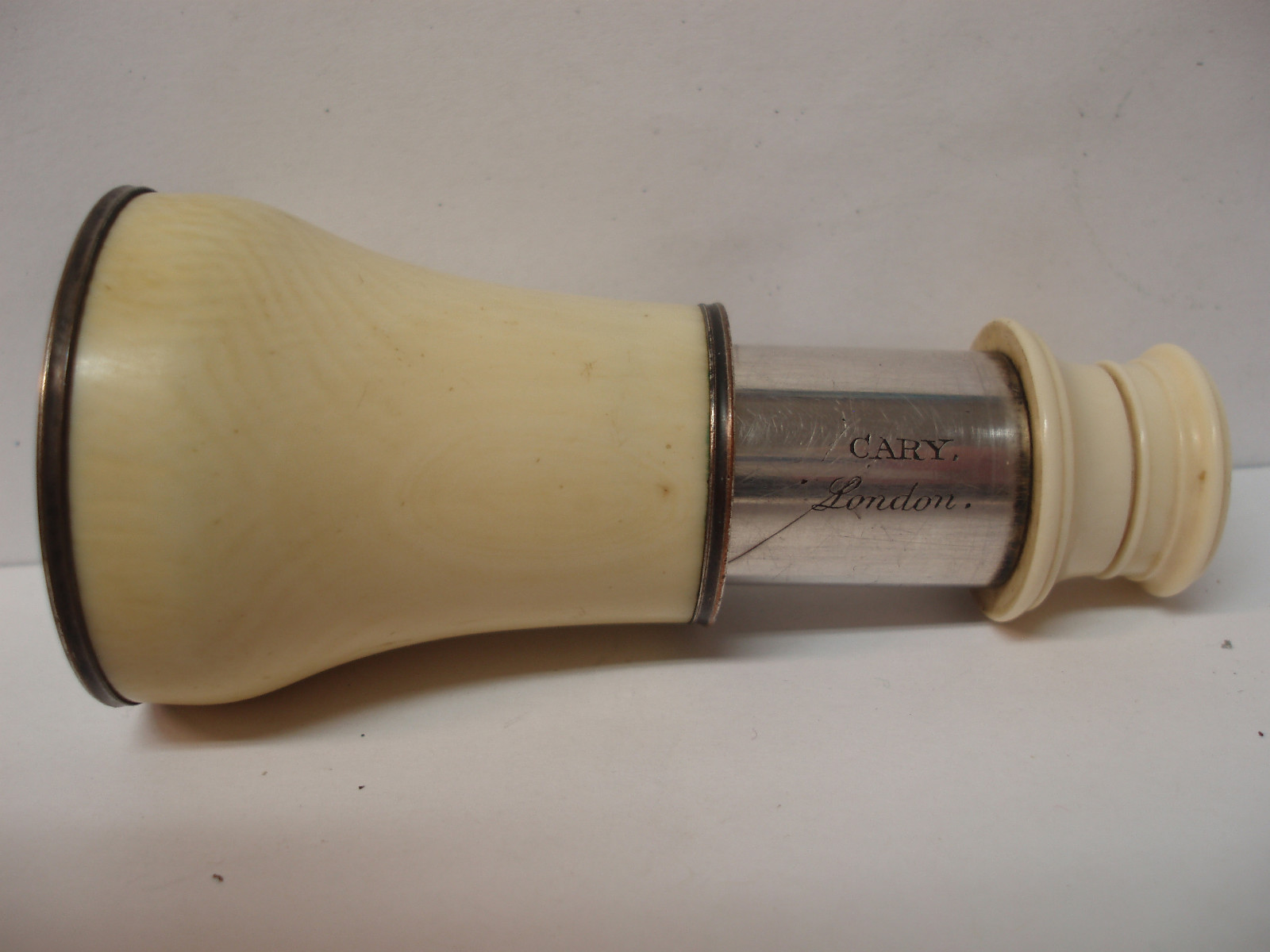
Figure 5A.
An ivory prospect glass, made by Cary. Palm-sized,
low-power telescopes such as this were popular for observing/spying on other
attendees of a theater, party, etc. Image from an internet auction.

Figure 5B.
Circa 1840-50 octant by Cary.

Figure 6.
An ivory ruler.
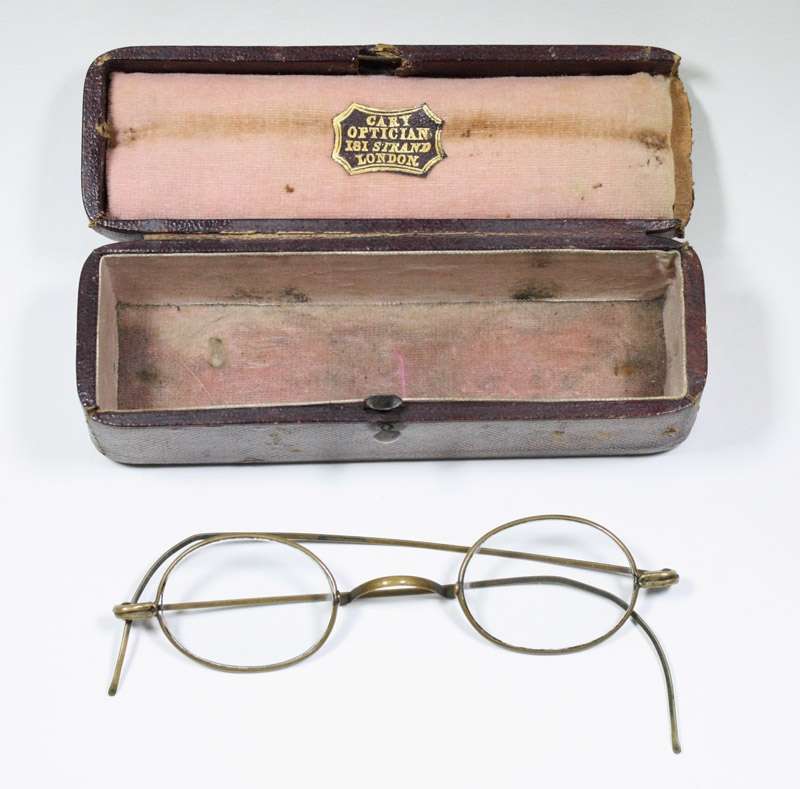
Figure 7.
A pair of eyeglasses and case, by Cary. The 181 Strand address dates these spectacles as being made after 1828.
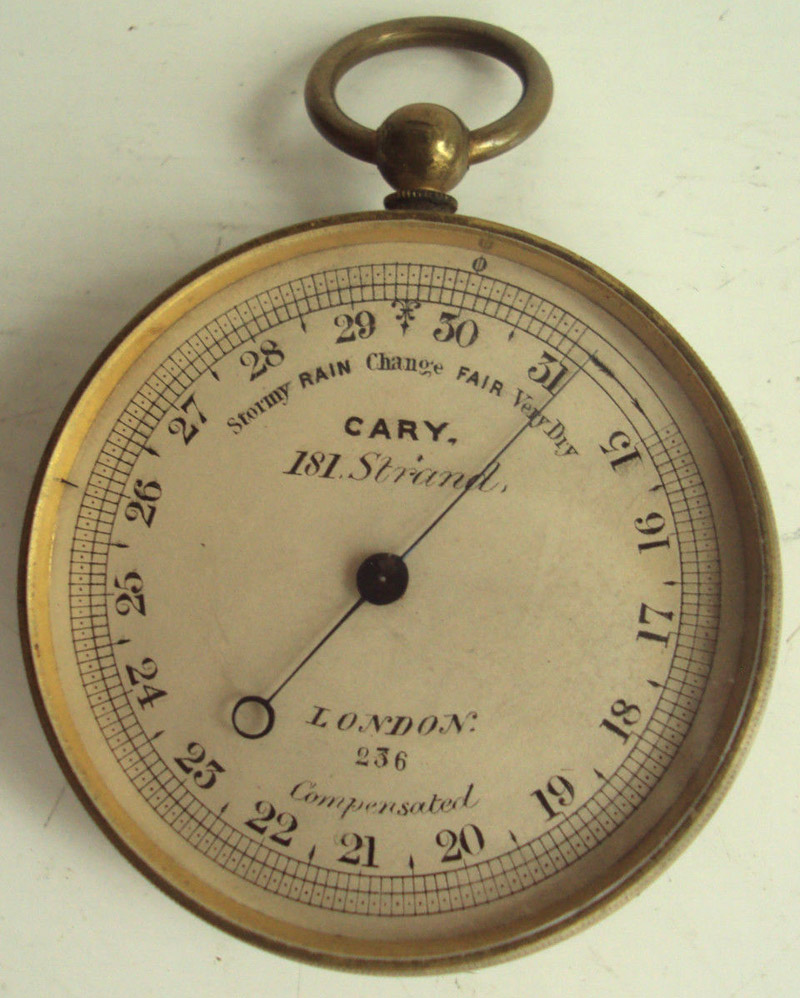
Figure 8.
A pocket barometer by Cary, 181 Strand.
William Cary was the youngest of four sons of George and Mary Cary. His eldest brother, George (ca. 1753-1830), later operated a haberdashery. The second brother, John Cary, became a mapmaker. John and William also operated a joint venture to make globes, compasses and other such tools (see Figures 36 and 37 at the end of this essay). The other brother, Francis (ca. 1756-1836), became an engraver, and lived in Chelsea.
William served an apprenticeship as a maker of philosophical instruments (i.e. scientific equipment) with Jesse Ramsden (1735-1800). Ramsden was a highly regarded instrument maker. Some examples of his work are shown in Figure 35, at the end of this essay. Through Ramsden, Cary would have learned considerable skill in working with brass, glass and other materials.
William established his independent business ca. 1785, at 182 Strand. He produced a wide range of scientific instruments and was well known for his quality workmanship. The Dictionary of National Biography especially noted that, “He constructed for Dr. Wollaston in 1791 a transit circle - the first made in England - two feet in diameter and provided with microscopes for reading off. In 1805 he sent to Moscow a transit-instrument described and figured in Pearson's 'Practical Astronomy', for the safety of which Bonaparte provided in 1812 by a special order. A circle of 41 centimetres, ordered from Cary by Feer about 1790, is still preserved at the Zurich observatory. He was, besides, the maker of the 2 1/2-foot altitude and azimuth instrument with which Bessel began his observations at Konigsberg, and of numerous excellent sextants, microscopes, reflecting and refracting telescopes, &c.” William was a charter member of the Astronomical Society, and produced monthly meteorological reports for The Gentleman’s Magazine. Brother John’s mapmaking shop was next door, at 181 Strand. Globes produced by William and John are marked “181 Strand”. George’s hat shop was nearby, at 63 Strand.
The January, 1820 issue of The Gentleman’s Magazine reported, “The houses numbered 181 and 182 Strand, occupied respectively by the brothers John and William Cary, were completely destroyed by fire on Monday, January 17th, 1820”. The Carys then moved their businesses to 86 St. James Street.
The 1823 Kent’s Original London Directory listed “Cary Wm. optician, 277, Strand”. The 1825 list of members of the Royal Astronomical Society also gave William’s address as 277 Strand. However, Kent’s listed “Cary John, optician, 182, Strand”, as well as “Cary John, engraver & mapseller, 86, St. James's-street”. The 277 Strand shop appears to have closed after William’s death.
William Cary died as a moderately wealthy man on November 16, 1825. In his will he left “To three brothers John Cary, George Cary and Francis Cary £1000 each. To Mrs. Penelope White, of Queen Street, Southwark, £500, and to her children, John White, Susanna White and Penelope Dare £200 each. To wife Elizabeth £500 a year for life. Residue to said three brothers for life equally and then to George Cary and John Cary, sons of brother John Cary”. The significance of Penelope White and her children is not apparent. The properties on the Strand were rented, and so not mentioned in the will.
Nephews George Cary and John Cary Jr. continued to operate the optical and scientific instrument business at 182 Strand. They retained the business name “William Cary” for some time. George and John Jr. do not appear to have produced optical instruments. All accounts indicate that Charles Gould was the manager and head machinist for the Cary business. This would have been a logical arrangement, since Gould was an experienced optician, whereas the Carys were map- and globe-makers, who would have had very little practical knowledge of glass- or brasswork. In 1828, the William Cary business moved next door, to 181 Strand, possibly merging with John Cary Sr.’s mapmaking operation. An 1830 publication described the optician’s business as “J. Cary”. Upon John Cary Sr.’s death in 1835, he left the 181 Strand lease to sons George and John Jr. The 1841 Kelly’s Directory referred to the optical business as “William Cary”, suggesting that the boys returned to their uncle’s name. The business remained at 181 Strand for many decades and through several ownership changes.
On June 10, 1826, The London Mechanics’ Register announced “Mr. C. Gould’s Patent Portable Compound Microscope” (Figure 9). That pronouncement implies that the microscope had only recently been released. The juxtaposition of William Cary’s death and Gould announcing this microscope under his own name suggests that Gould was enjoying an increased degree of freedom with the business. Indeed, many contemporary reports describe microscopes and other instruments as being “Gould’s”, and simply mention Cary as the place to meet Mr. Gould and acquire his inventions.
The magazine described the instrument, “The extreme portability of Mr. Gould's Microscope, which is enclosed in a case measuring only four inches by three, and its great magnifying power, recommend it strongly to the attention of the naturalist, mineralogist, and botanist, as it has sufficient powers to discover the most minute animalculae and seed-vessels, and has also the uses of the single, compound, opaque, and aquatic microscopes. Its construction obviates the want of light when a high magnifying power is used with the compound body, and it may be carried in the pocket without the slightest inconvenience. Mr. Gould's pocket microscope is made and sold by Mr. Cary, of No. 182, Strand, and its various parts are correctly represented in the frontispiece to the present number. An interesting pamphlet, from which we shall probably select a few extracts, has been recently published by Mr. Cary, illustrative of the wonders which the microscope unfolds to the view of man, and containing clear and explicit directions for collecting microscopic objects, and of preparing them for examination”.
The “pamphlet” quickly became a 50+ page hardbacked book. Gould apparently modified it several times within a few years, issuing the sixth edition in 1829 (Figure 11). A pdf of that book may be downloaded from http/::microscopist.net. The first few pages describe how to assemble and use this microscope. Three lenses were provided, for use individually or in combination with each other, either as a simple microscope or in conjunction with the compound body. Accessories were also described, including a live box, “slides filled with curious objects”, stage forceps, dissecting knife and forceps. Gould instructed that the end of the forceps includes a spoon, “for taking up a single drop of water.”
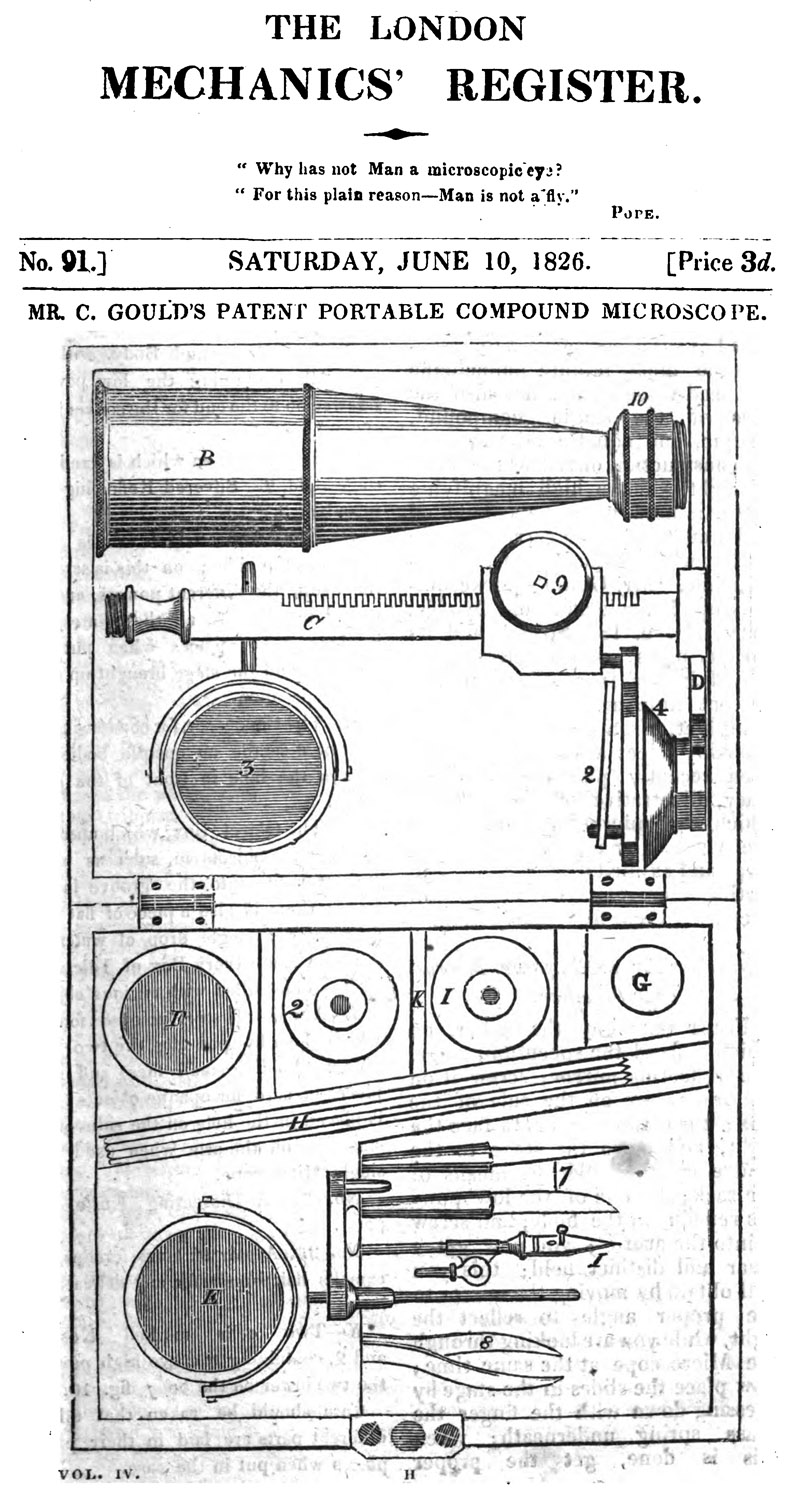
Figure 9.
Front page of The Mechanic’s Register, 1826,
announcing Charles Gould’s new microscope.

Figure 10.
In addition to the W. Cary shop, numerous other
scientific instrument dealers sold Gould microscopes. Illustrated are excerpts from catalogues by
(A) Edward Palmer, 1840,
(B) Benjamin Pike, 1848 catalogue,
(C) John Hewitson, 1847,
(D) Bland and Long, 1854. Note that Hewitson states that he manufactured all the instruments he sold. I have owned a Gould-style microscope signed
by Cox (London), and Turner’s ‘The Great Age of the Microscope’ includes
specimens signed by Bate (London), Banks (London), Harris (London), Cutts
(London), Dolland (London) and Duncan (Aberdeen). Unsigned microscopes are
still very abundant.
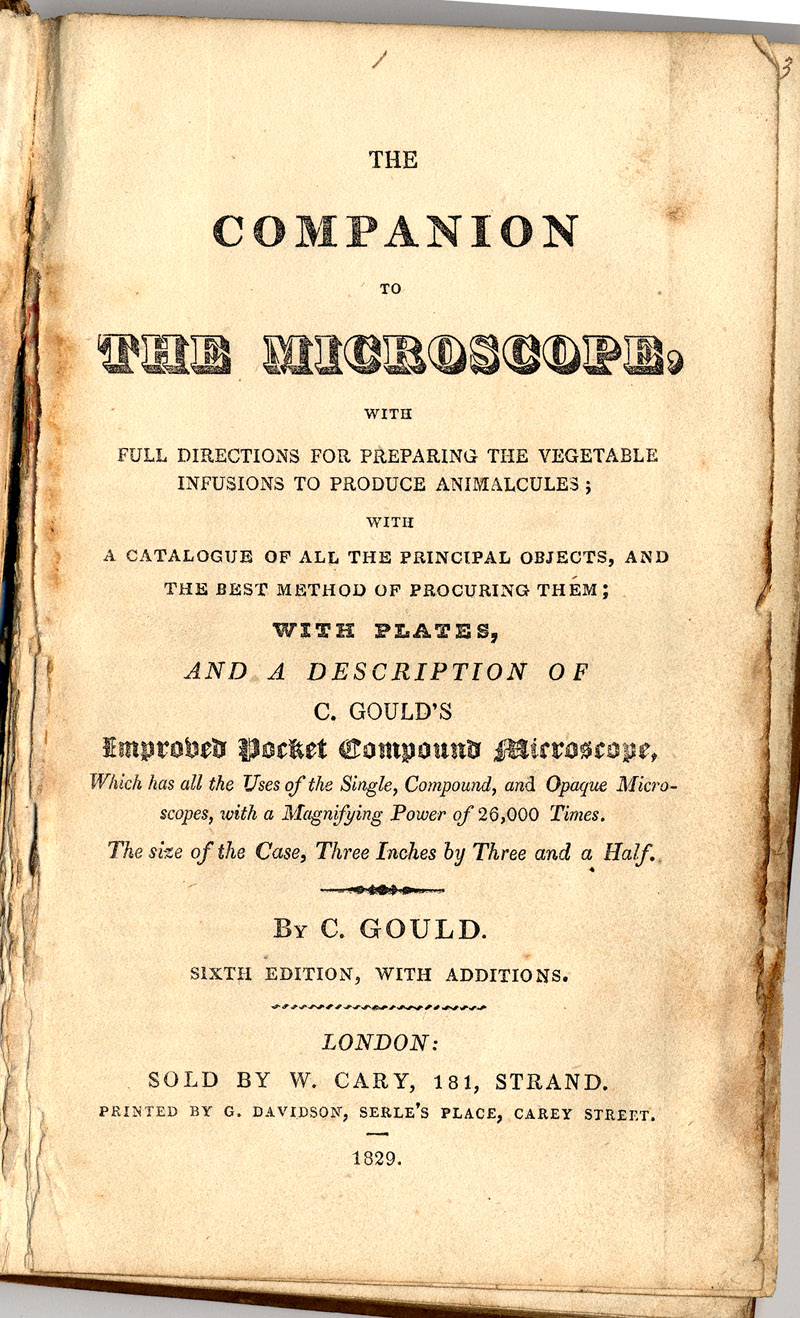
Figure 11.
Front page of the 1829, sixth edition of Charles
Gould’s “The Companion to the Microscope”. A pdf of the complete book can be
downloaded from http://microscopist.net/CGouldBook1829.pdf
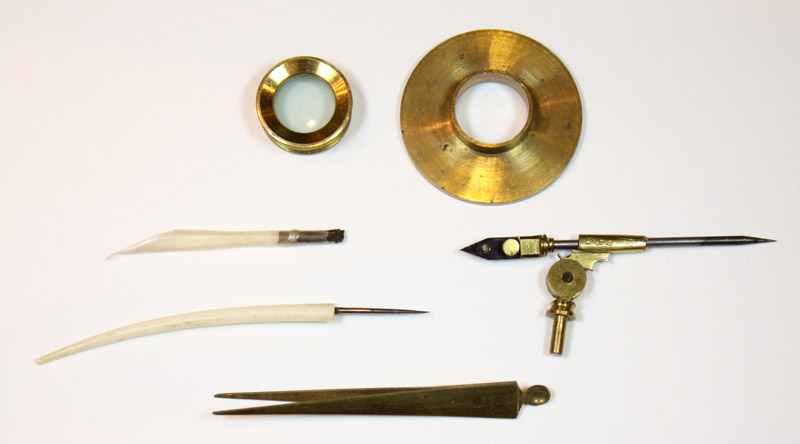
Figure 12.
Accessories that accompanied the ca. 1828 First Model case-mounted microscope shown in Figure 1A at the time of acquisition, and were listed by Gould as accompanying the microscopes he produced. Clockwise from top left: live box, stage mount for the live box, steel-pointed stage forceps, brass forceps with spoon at one end, a dissecting needle with ivory handle, and a brush made of fine hairs inserted into the end of a feather shaft. Originally, a small knife with a handle like that of the needle would also have been included.
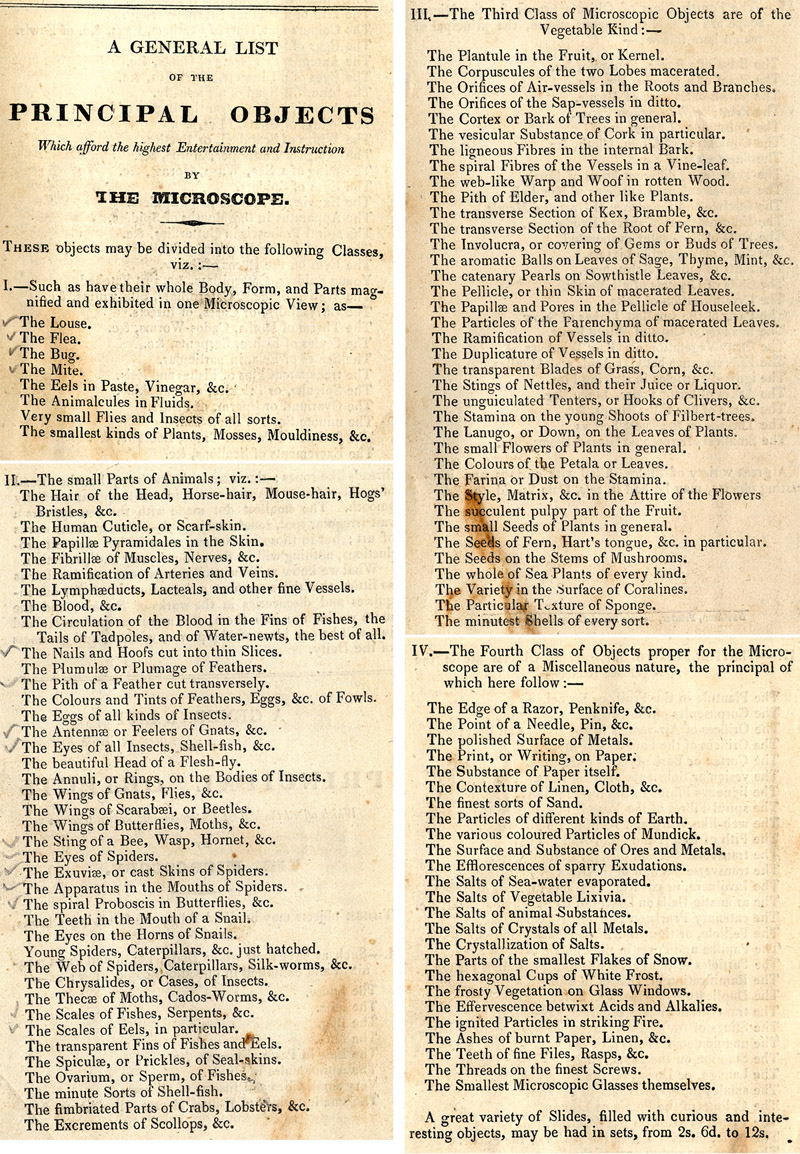
Figure 13.
Charles Gould’s list of objects for the microscope,
from the 1829, 6th edition of his Companion to the Microscope. This
list predates Andrew Pritchard’s famous list of objects by almost a decade.
The bulk of Gould’s 1829 book is dedicated to descriptions of specimens that may be obtained for viewing, and how to prepare them. To quote Gould from the preface: “Many persons who have purchased Microscopes, after entertaining themselves and friends with the slides that accompany the instrument, have found themselves at a loss for new objects; consequently, it has been laid aside, as of little further use: but no invention is capable of affording more entertainment and instruction than this instrument, opening a new world, and displaying the most extensive scenes of creative power, wisdom, and design. It is presumed this small treatise will be the means of showing a more extended field, as it contains every direction with regard to procuring and applying the most interesting subjects for examination by the Microscope: also the method of producing those wonderful objects of the minute creation, the animalcules of vegetable infusions. It comprises, likewise, a list of upwards of two hundred different objects, and a Description of C. Gould’s New Improved Pocket Compound Microscope, the most complete Microscope made”.
It is particularly noteworthy that Gould’s list predates Andrew Pritchard’s more famous A List of Two Thousand Microscopic Objects by nearly a decade.
Additional information on Gould’s microscopes and his companion books can be found at http://www.microscope-antiques.com/carysmall.html and http://www.microscope-antiques.com/gouldsbooks.html
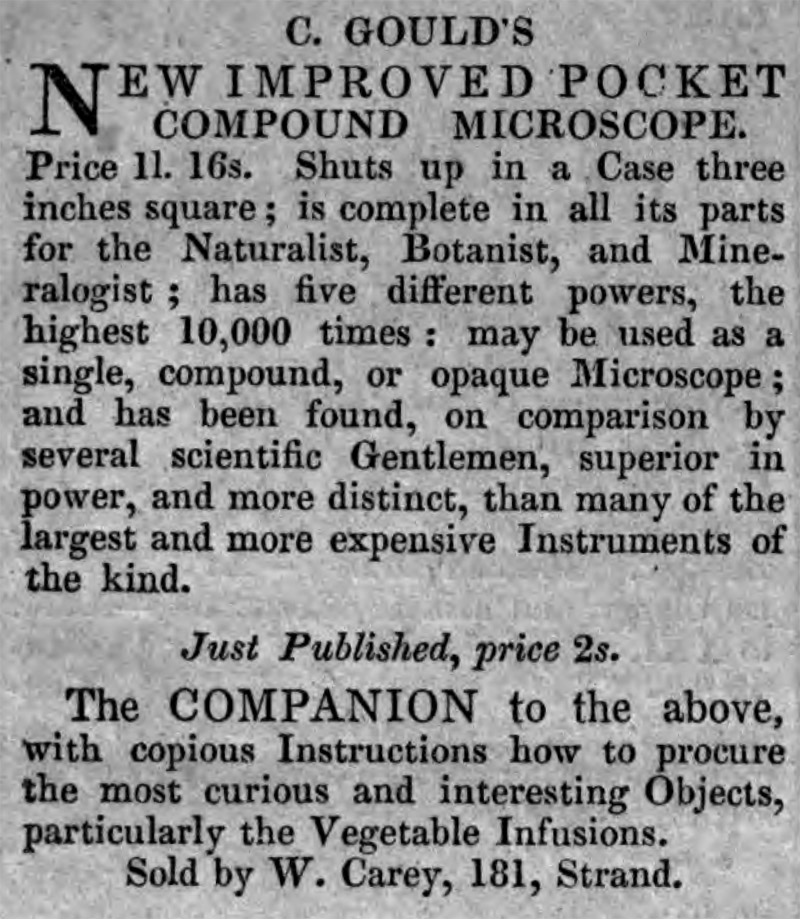
Figure 14.
An 1828 advertisement for Gould’s microscope and
companion book. From ‘Thermometer and Pyrometer’, by T.S. Traill.
Contemporary accounts credit Charles Gould with several advances in the preparation of objects for the microscope. At the beginning of the 1820s, sliders made of ivory or wood were the most common method for mounting specimens (Figure 15A). Thin slices of translucent mica were used to hold specimens. Imperfections in the mica mineral, and unevenness of slices, limited resolution of objects. Glass is optically far superior to mica, and came into greater use during the 1820s.
The 1829, sixth edition of Gould’s book described a new method for making microscope slides from two pieces of glass and some paper. “Take two slips of glass about the size of ivory slides; then get a piece of writing paper, with holes, of the same size; wet one side of the paper with gum-water, and lay the glass upon it, suffering it to dry; then place your objects in the holes, wet the other side in the same manner, and lay on the other glass”. Examples of such slides are shown in Figure 15B.
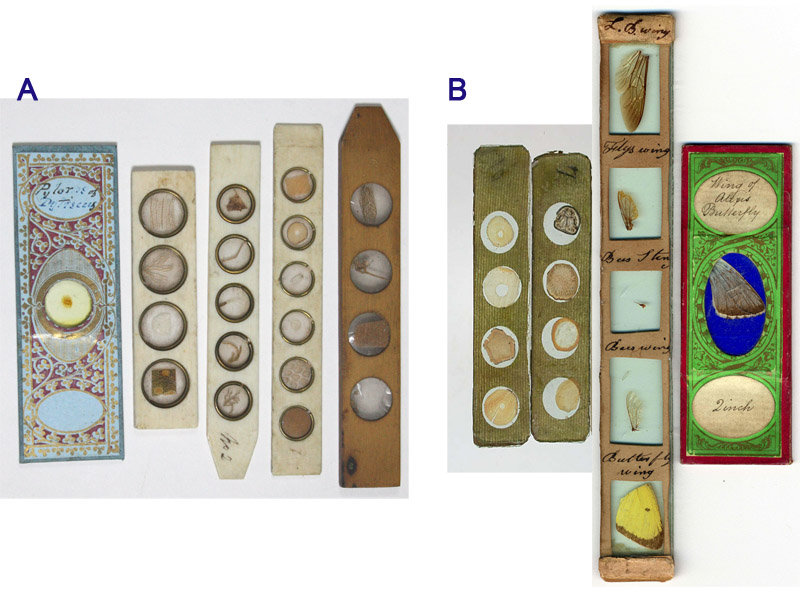
Figure 15.
One of Charles Gould’s contributions to microscope
slide-making.
(A) Prior to the
1820s, microscope slides/sliders were made of ivory, bone or wood, which held
specimens dry-mounted between two mica discs.
(B) A method attributed to Gould, using two glass slides, with a
thick paper spacer glued between. Specimens were held within circles, squares,
etc. cut out of the spacer. A disadvantage of this method was that the thick
top glass precluded use of high-powered lenses for detailed microscopy. This,
and similar techniques such as Darker’s method (see Figure 16), appear to have
been used primarily for woods and other large specimens, and fell into disuse
within a few decades, as thin glass cover slips became more common. For size
comparisons, RMS standard 1x3 inch slides are shown in each panel, which were
made by (A) John T. Norman and (B) Edmund Wheeler.
In 1829, Gould also recommended that “to preserve curious objects, they may be fixed on some slips of glass with gum-water, and another glass placed over them, cemented together with sealing-wax” (Figure 16). Such early use of sealing wax to cement slides appears to have involved application of wax to the edges of glass slides, with some wax penetrating between the slips by capillary action and thereby bonding the glass pieces together. An improvement upon that technique was described by Andrew Pritchard (1847), John Quekett (1848), and William Notcutt (1859), wherein bevels were ground into the inner edges of the glass slips, thereby permitting the wax to better flow between the glasses and enhance the seal. This method also permitted the maker to wipe the wax off the outer edges of the assembly, permitting a cleaner finish. Previously, as with the method described by Gould in 1829, excess wax was retained along the edges to increase adherence. Neither Pritchard nor Notcutt gave credit to the designer of the beveled-edge slide, although Pritchard is often given credit nowadays, based upon the attachment of his name to some such slides (but by no means most of them). However, John Quekett specifically credited development of the bevel-edged advance to William H. Darker, a Fellow of the Microscopical Society of London / Royal Microscopical Society and a highly regarded manufacturer of superior quality slides and scientific equipment.
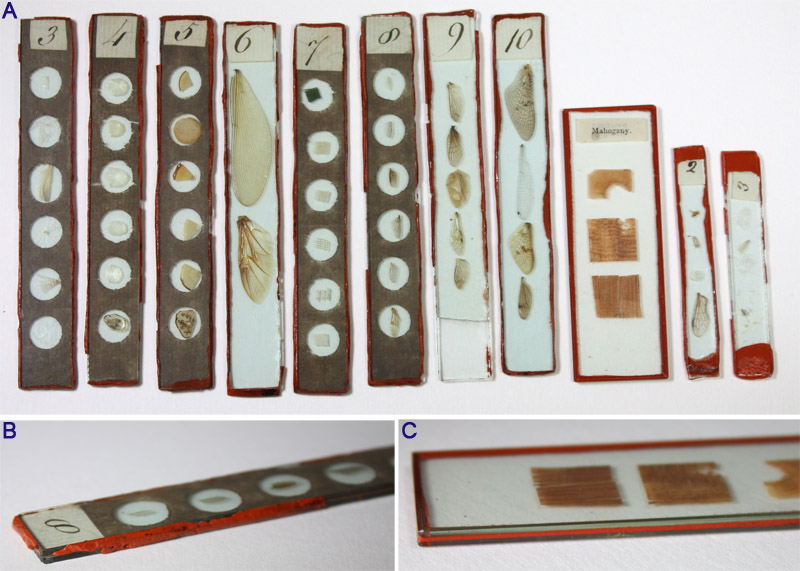
Figure 16.
(A) A partial series of slides matching Gould’s description of sealing slides with wax. The paper used to form the spacers in slides 3, 4, 5, 7 and 8 is similar in color and texture to the paper used in the Figure 15 slides. Toward the right, a standard 1x3 inch slide of mahogany wood section prepared by “Mr. Darker’s method” is shown for size comparison.
(B) Edge view of an early wax-sealed slide, showing rough edges on the glass slips and wax protruding around the sides.
(C) Edge view of a ca. 1848 William Darker preparation, showing the beveled inner edges, filled with sealing wax, and the clean finish characteristic of “Mr. Darker’s method”.
Thomas Gill, writing in 1830, attributed Gould with developing another novel method of specimen mounting. This was the precursor of a technique that is still in common use today: fastening of a cover slip to a glass slide, with a specimen held between. In Gould’s case, the cover slips were made of thin sheets of mica. As a final touch, Gould glued paper over the top of slide, protecting and helping to adhere the cover slip (Figure 17). That feature was commonly used by slide-makers for the next half-century. Quoting Gill, “Mr. C. Gould's mode of mounting microscopic objects, to be viewed under highly magnifying powers. - Mr. Gould furnished us with some of the scales or feathers from the wing of a butterfly, properly mounted for viewing under a power of the twentieth of an inch focus, or even higher; and which, as it is a very convenient method, and readily practised, we think deserving of being made known. The feathers being placed in the centre of a slip of crown glass, one and a half inches long, and half an inch wide, are covered with a slip of very thin talc or mica, which is cemented at each end upon the glass slip, by means of a solution of gum-arabic in water, to which a little pure acetic acid is added; and the talc is itself covered and defended from injury, excepting in that part of it which is necessarily left open in order to view the objects, by being covered with a piece of thin paper, the size of the glass slip, and having a circular aperture in its centre, a quarter of an inch in diameter, and which paper is also cemented by gum-water. There is quite sufficient space upon this covering paper to receive in writing the name of the object inclosed, together with a number or other mark of reference to it, and its thickness preserves the talc from being injured, although it is not so great as to present any impediment to the employment of highly magnifying powers in viewing the objects”.
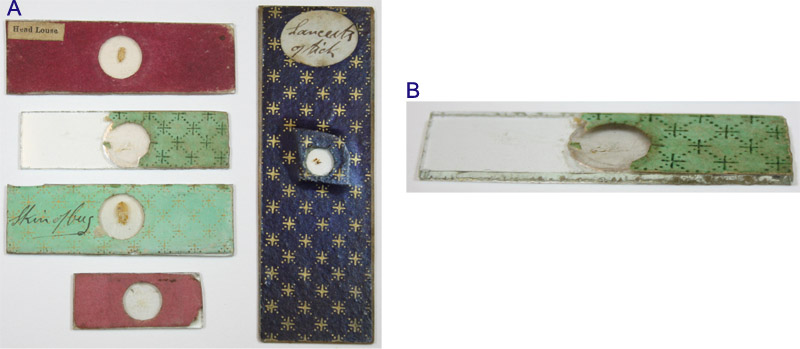
Figure 17.
Another contribution of Charles Gould to the evolution of microscope slide-making.
(A) The four small slides on the left were made according to what Thomas Gill described as “Mr. C. Gould’s Mode” of slide making. The specimens were dry-mounted between a mica cover slip and a glass
slide. Paper was glued on top, to help hold down the cover slip and prevent it from being dislodged. The torn paper on the damaged slide reveals the mica cover slip. The top red-papered slide with the printed label was retailed
by Andrew Pritchard (it is part of a set that was acquired in a case that is
embossed with Pritchard’s name and address). The two slides with pale green papers with star prints were produced by professional slide-maker James W. Bond. The lower, small slide is an early test slide of butterfly scales, possibly retailed by Cary. A later, balsam-mounted 1x3 inch slide by Bond is shown for size comparison.
(B) An enlarged, oblique view of the damaged J.W. Bond slide. All of these slides have paper coverings on the top only, as Gill described for Gould’s technique. Cut edges of the glass slides were left rough.
Gould provided a step in the evolution of another mounting technique (Figure 18). Thomas Gill, in 1828, wrote, “On an improved Apparatus or Slider for viewing the Animalcules in water under the Microscope. - The Editor has formerly described an apparatus consisting of two slips of glass cemented together, with a piece of card laid between them, and having a gap or notch cut in one side of it, to form a kind of cell, into which cell, water, containing animalcules in it, being placed, the water was held in the cell by the capillary attraction, and was thus prevented from falling out, when the slider was laid horizontally on the stage of the microscope. The Editor, some time since, furnished Mr. Gould, at Mr. Carey's, the optician in the Strand, with one of these sliders, and which he immediately adopted in his microscopic apparatus. He has since, however, laid aside the interposed card, and now merely cements the two slips of glass together, by heating them, and coating them with sealing wax, excepting a gap or cavity in one side of each, in the middle of the slip; and then again heating them, he joins them together, thus forming a cavity which holds a thinner stratum of water than when the card was interposed. This is a great improvement on the original method; and when one of the glass slips is only the twentieth or thirtieth part of an inch in thickness, as is the case with some of the Editor's making for his own use, it forms an exceedingly commodious cell for this purpose. Mr. Gould clears out the water by means of a slip of paper introduced between the two glass slips”.
Gould again modified the wax-sealed fluid slide by using a large piece of glass for the bottom and for the top, a small, thin glass the size of a cover slip. Gill described, “Mr. C. Gould's slider for viewing animalcules in water. - We have, in our last volume .. described Mr. Gould's mode of forming these useful sliders; but as example is sometimes better than precept, so we give in (Figure 18B), a front and edge view of one of them, of about the size he usually makes them. The boundaries of the sealing-wax, which he applies on the inner surfaces of both slips of glass, when heated sufficiently to melt it .. Instead of employing two slips of glass, the full length of the slider, it is sufficient, and particularly in using a covering one of very thin plate glass, that it be merely long enough to cover the cell, formed near one of the edges of the slider, and as indicated by the dotted lines in that figure”.
Gill changed that slide-making style by sealing the specimen-holding well with wax on all four sides. Specimens were placed within this well, then a thin cover slip was laid across the top (Figure 18C). Gill wrote, in 1829, “The Editor's pond or shallow cistern for viewing animalcules, &c. in water. - We also embrace the present opportunity of showing the form of this very useful and readily formed pond, and which we have so often had occasion to mention in the course of giving these articles on the microscope. (Figure 18C) shows a slip of glass, near the middle of which, when heated over the flame of a lamp or candle, two cross lines have been drawn with a stick of sealing-wax formed into a point, and also two others along the edges of the slip, to meet the two cross ones, and thus forming the four sides of the pond. The sealing-wax is applied so thinly, that the pond is exceedingly shallow, and yet it allows of the motions of the animalcules in it, when covered with a very thin plate of glass or talc, as shown in the figure. The chief advantage of this over Mr. Gould's slider consists in the great facility of wiping the parts clean after each experiment has been made with it”.
Another variation of Gould’s sealed trough method was developed by James Holland. That modification was similar to Gill’s with a square well in the center of a glass slide but Holland formed his wells with “white lead, ground in drying linseed oil”. A specimen, in a mixture of alcohol and water, was placed in the well, which was then permanently sealed with a cover slip and lead-oil paint. Gill stated, “that although it is upwards of a fortnight since he prepared this, and two other similar objects, no visible escape of the fluid is perceptible!” and “We are glad to add, that, after the test of three months, it is still in a perfect state; and we may therefore hope, that its durable preservation is insured. We also learn that Mr. C. Gould has adopted this excellent method, with a similar success, and can therefore confidently recommend its application to all similar cases, or where we would wish to preserve delicate objects in a convenient state, as nearly like their natural one as may be, and in which state only can we expect to see the beautiful and minute ramifications of the blood-vessels, &c., extended over the various parts, and other minutiae; but which, in the drying of such objects, usually shrink up, and become obliterated”. This was the forerunner of the fluid mounts that were later produced by Alexander Hett and other professionals.
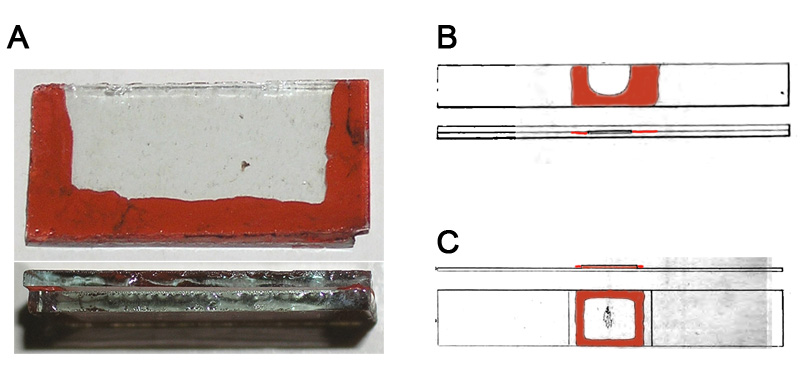
Figure 18.
Further contributions by Charles Gould to
development of microscope slide-making techniques.
(A) Gould developed a simple trough for viewing specimens in water,
consisting of two glass slides sealed together on three sides. Fluids were
retained in the thin cavity by capillary action, permitting the slide to be
laid horizontally on the microscope. Shown are side and top views of a surviving Gould trough. Actual size is approximately 1 inch (2 1/2 cm) wide.
(B)
A modification by Gould, with a small specimen holding space formed between two
larger glass slides.
(C) Thomas Gill
then modified Gould’s pattern, by instead forming a square well of wax in the
center of a slide, which can hold a small “pond” of water and specimens. A
cover slip was then placed over the specimen, suspended by the wax.
The black and white, 1829 drawings shown as panels B and C were
color-enhanced to emphasize the location of the wax. Panel A is adapted, with permission, from
http://www.microscope-antiques.com/carysmall.html.
While the water troughs of Gould and others allowed fascinating views of live organisms in water, the microscopist would often be frustrated when specimens swam out of the field of view. Manually moving the trough on the microscope’s stage would be jerky, plus the trough might fall off the stage. Gould remedied that problem by developing what may have been the first x-y moveable microscope stage (Figure 3E). A rotating knob on either side of the stage allowed the microscopist to adjust the stage either left-right or up-down with ease. In that each hand controlled only one knob, a user could easily track an organism as it traveled around the miniature aquarium. Gill described “Mr. Gould's adjusting stage for the Microscope” thusly, “Mr. Gould, at Mr. Carey's, optician, in the Strand, has recently constructed an adjusting stage for the microscope, by which the observer has it in his power to follow the motions of an animalcula in water with great facility. He has effected this improvement in the following manner: Upon the flat plate, composing the usual adjusting stage, two flat bars of brass are screwed, one in front of, and the other behind, the circular cell in the middle of the stage ; the inner sides of these bars are bevelled, so as to receive the dove-tailed edges of another flat plate within them, which is made to slide across the stage towards either side, as may be required, by the action of a pinion with a milledhead underneath it, and which pinion works into a toothed rack, formed upon the inner edge of the second plate; the pinion having a cylindrical neck or pivot close to it, which turns in a cylindrical hole, made in the right hand side of the stage to receive it; and the pinion is kept in its place by the shoulder of the stem of the milled-head being pressed against the under side of the stage, by a central binding screw in the milled-head, as usual: the milledhead itself being fitted upon a squared part of the axis of the pinion. Upon the second plate two other similar bevelled bars are also screwed, one upon each side of it, and, consequently, at right-angles to the two first mentioned ones; within these, the dove-tailed edges of a third flat plate also move backwards and forwards, by means of a second pinion, acting in a toothed rack, formed upon the left side of that plate; the pinion turning in a hole made in the left hand side of the second plate, and being mounted with a milled-head underneath it, in the same manner as that first described. The middle parts of both the moveable plates are removed, so as not to impede the light from passing up from the illuminating mirror or speculum placed underneath; and the objects being supported upon a slip of flat glass, or in a concave one, as usual, their motions can be most conveniently followed, by the observer taking the two adjusting milled-heads of the stage, one between the thumb and fore-finger of each hand, and thus turning either or both of them, as may be required. The milled-head of the pinion, which, by working into a rack mounted into, or formed at the back of, the pillar or stem supporting the microscope, serves to adjust the foci of the different lenses, being also within convenient reach of the right hand, so that the whole adjustment is entirely under the control of the observer, who will find it a most valuable assistant in his microscopic investigations. The whole forms an exceedingly neat combination of parts, and reflects much credit both upon the inventor of it, and upon the workman who has executed it.”
Robert Brown, in 1827, described a phenomenon that came to be known as “Brownian motion”, wherein microscopic objects suspended in water can be observed to be jostled about by collisions with the water molecules. The cause was long in debate among scientists, and was not identified for several decades afterward. An anecdote related by Thomas Carpenter in July, 1829, indicates that Charles Gould was among the curious, “I called in at the shop of Mr. Cary, optician, in the Strand, where I was informed by Mr. Gould, that some persons being of opinion that the motion of the molecules, discovered and described by Mr. R. Brown, of the British Museum, was either occasioned by the action of the breath of the party examining them under the microscope, or by the watery particles evaporating. In order to ascertain the fact, he had placed some exceedingly minute particles' of gamboge in a fluid, which he secured hermetically, between a slice of talc, and a glass slip, so that they could neither be affected by the breath nor the atmosphere. At the time I observed these particles, they were in a constant motion of attraction and repulsion; and Mr. Gould informed me, they had then been between the glass and talc for seven days previous to my observing them. The lens under which I viewed them, was the thirtieth of an inch focus”. Carpenter’s story also indicates that, by that time, Gould was making fluid-filled microscope slides which were permanent to some extent.
Gould described another microscopic phenomenon, in 1833, “Having occasion to prepare some of the scales from different fish for the microscope, in viewing one as an opake object, in a drop of water, I observed a very curious phenomenon ; which was, a number of minute shining particles in motion, moving in all directions, appearing and disappearing, and when on the surface reflecting the most brilliant prismatic colours, producing a beautiful microscopic effect. I have examined them with various forms of the microscope, particularly under a fine achromatic belonging to Mr. Joinville; and they have every appearance of animalcula. Several of my microscopic friends who have seen them are of the same opinion, particularly the above gentleman, who has paid great attention to microscopic pursuits. Whether they are living animalcula or not, I am at a loss to determine, and must leave it for the investigation of our microscopic friends. The readiest way of examining them is as follows: Take a single scale from any fish (say a fresh herring); put it on a flat piece of glass, and cover it with a drop of pure water; press the scale to make it lie flat on the glass; place it under the microscope with a piece of black paper, or the black ivory stage-piece of the microscope, as it must be viewed as a perfect opake object, or the effect is not seen: by means of a condenser throw a strong light upon it from a lamp or candle; and you will observe a multitude of minute bodies in motion on the scale; but they are much more visible in that part of the drop of water which the scale does not occupy, forming a most beautiful and interesting microscopic object”.
All aspects of Cary microscopes were well regarded. Gill wrote, in 1829, “On Mr. Gould's Microscopic Lenses, of high powers - The Editor had an opportunity lately afforded him at Mr. Thomas Carpenter's, by Mr. Gould, of judging of the magnifying powers of several of these lenses, in a comparison with those of his own Varley's microscope, and found that the highest exceeded his of the sixtieth of an inch focus; being, perhaps, equal to the eightieth of an inch. Of their value in respect to distinctness, he was not able to judge, they not being mounted sufficiently accurately to test them. Mr. Gould stated, that he should be able to sell them at very moderate prices”.
William Wollaston (1766-1828) invented the “Wollaston Doublet” for the simple microscope in 1812. This eyepiece consists of two plano-convex lenses, with their plane sides towards the object, and the lens of shortest focal length next the object. That arrangement was capable of far greater resolution than the single lens eyepiece. An improved version of the Wollaston doublet was published shortly after the inventor’s death, in 1829. Gould promptly integrated this advance into his microscopes. Gill described, in 1830, “The late Dr. Wollaston's Microscopic Doublet - We are now able to congratulate our microscopic readers on this very superior instrument being afforded at only one fourth of the price hitherto charged for it. Mr. C. Gould, at Mr. J. Cary's, the celebrated optician in the Strand, has just put into our hands one of these instruments, in order that we might be able to prove its powers with the most difficult test objects. And, accordingly, we have placed under it the long-notched, or cleft scales of the brassica butterfly, and also those of the podura, with a doublet of about the twentieth of an inch compound focus, and another of about the thirtieth of an inch focus, and never have we viewed those objects with greater distinctness, or under more favourable circumstances! The facility of using this microscope, is likewise a considerable recommendation in its, favour; as the proper management of the light, an object of the greatest importance, is now readily acquired; and its nice adjustment for the focal distance is effected by means of a finely threaded screw. We have no doubt that this superior instrument will now become a favorite with the microscopic part of the public, and greatly contribute in extending the use of that invaluable aid to our limited vision, the microscope. This instrument possesses the power of exhibiting the minute bodies with extreme distinctness; and which, as Dr. Wollaston justly observes, in his description of it in the Philosophical Transactions, ‘is absolutely necessary for an original examination of unknown objects’. Its great portability is also no small recommendation in its favour, as it is inclosed in a neat mahogany box, which is only two inches in depth, two and a half inches wide, and three and a half inches long; and can therefore be conveniently carried in the pocket”. Also notable in this statement is the naming of the optician’s business as “J. Cary”, implying that William Cary’s brother had re-named the shop.
An advertisement in September of 1829 described a very large projection microscope, “C. GOULD'S IMPROVED LUCERNAL MICROSCOPE. This Instrument is admirably calculated for viewing large or small objects, particularly insects, the field being capable of taking in, at one view, entire, moths, butterflies, beetles, &c. By this instrument that superb insect the curculio, or diamond beetle, is magnified to 19 inches, shewing its variegated brilliancy in the highest perfection. The entomologist, may examine any rare insect without injury, and the mineralogist will be afforded the means of viewing the beauties of his cabinets in a unique and splendid manner. A microscope of this description has long been a desideratum; such instruments have, hitherto, been both expensive and complicated; this one is with confidence offered to the public, and will be duly appreciated. Its prominent qualities are, splendid effects united with great facility in its management. Made and sold by W. Cary, 181, Strand, price 2£ 18s. to 3£. 13s. 6d”.

Figure 22.
1833 Advertisements for Cooper and Cary’s projection
microscope.
Gould’s optical prowess enabled the first public displays with a projection microscope using artificial light. This occurred on February 18, 1833, as a joint venture between John T. Cooper and John Cary.
From the Microscopic Journal, “As microscopic research is for the most part an amusement rather than a profession, it cannot be a matter of surprise that many resort to it as a means of intellectual pastime, which is sure to terminate in beneficial results .. The first and most important attempt to develop to the public gaze the microscope on a large scale, was made by Mr. Carpenter, of Regent street, who for many years exhibited a solar microscope, for the gratification of the public. The uncertainty, however, of the weather, and state of atmosphere generally, in this country, and more especially in the metropolis, was the great obstacle to this exhibition. This difficulty, at first sight insurmountable, was at length overcome by Mr. J. T. Cooper, who had for many years applied for private purposes, the oxy-hydrogen gases projected on lime, (known generally as the oxy-hydrogen light) as a means of illustrating in his laboratory and lectures, many of the important facts connected with light. At a meeting of a few scientific friends to witness the results of some experiments with this light, at Mr. Cooper's laboratory, then at the Aldersgate street School of Medicine (twelve years since) Mr. Cooper and Mr. John Carey, of the Strand, feeling assured of the principle and stability of the application, proposed to apply this substitute for the solar rays to the illustration of microscopic power, and accordingly arrangements were made, and a microscope constructed, adapted expressly to the peculiar nature of the light, which, as is well known, differs in many respects from that received from the sun. The first microscope (an experimental one) was opened in the Strand in the year 1832, nearly opposite the end of Norfolk- street; this spot was selected on account of the contiguity to Mr. Carey's workshops, as a matter of convenience only. When by dint of much time and experimental application, Messrs. Cooper and Carey had accomplished their labours to their satisfaction, the scientific public it will be remembered, were invited to attend at 21, Old Bond-street, on 18th of February, 1833, to witness the first public exhibition of the kind ever presented, in which the oxy-hydrogen light was made to perform all that had been hitherto effected with direct solar light; and it is but justice to those gentlemen to affirm, that this exhibition was considered to be, both by scientific men and the public at large, not only most creditable to the labours of the projectors, but the most interesting and important that had ever been offered to the public, and which could not fail to attract the attention of persons in every age, rank, and station in life; - but possessing the noble aim of enlarging the views of the multitude, by drawing their attention to the wonderful and beautiful adaptations of nature to secure her end. No exhibition was for a period better attended than was this; others in the course of a short time sprang up in various parts of the metropolis and the provinces, and two are even daily exhibited at the galleries of Practical Science in London, forming the leading attraction, and exciting the general interest and amusement of those who visit these institutions”.
From The Young Mechanic, “Beautiful Experiments on the Hydro-oxygen Microscope. - We were yesterday admitted at Stanley's, No. 21, Old Bond street, to a private view of one of the most extraordinary exhibitions we ever remember; it is denominated the hydro-oxygen microscope, and is an application of the light employed by Lieut. Drummond on the trigonometrical survey to microscopic purposes. A stream of oxygen gas, and another of hydrogen gas, (the chief constituents of water) are brought into union, and projected in an ignited state upon a mass of lime, producing a light of intense brilliancy, which, passing through a lens, throws the images of objects magnified from 10,000 to 500,000 times, in the manner of a solar microscope, upon a disk of 14 feet diameter. The inanimate objects consisted of fragments of insects' wings, of fuci, sea-weed, woods, hair, &c; all the minute external properties of which were shown upon an exaggerated scale. A few hairs of an infant appeared like tubes of two inches in diameter. A small portion of the human pericardium exhibited the courses of the arteries and veins. The penetrating nature of the light revealed the interior confirmation of the fleas and spiders in the object glasses. The sting of a bee was a monstrous barbed weapon, four feet long. The lancets of the horse-fly were sabres about two feet in length. The next curious part of the exhibition consisted of the small animalcules in a drop of water, some of which are seen preying upon each other. Some skeleton larvae were from their diaphanous texture, beautifully developed, exhibiting even the vesicle of air which enables them to rise or descend in the water; and some of the worms found in stagnant ditches, the natural size of which is a thread, appeared like the largest sized boa-constrictor. It is in short, an exhibition worthy to engage the attention of natural philosophers of the highest class, as well as of the merely curious. The instrument is constructed under the superintendence of Mr. Cooper, professor of chemistry, and Mr. Cary, the optician. The former gentleman attends and explains, very clearly and scientifically the different objects. The exhibition was crowded with company, including persons of rank and science, Lord Sidmouth Lord Dover, Mr. Faraday, Mr. Babbage, Professor Buckland, &.c. - London Times
From The Tourist, “perhaps, the most astonishing view of these animals, and of the wonders of the microscopic world in general, is presented by a recent improvement in the solar microscope - we refer to Mr. Gould's instrument constructed under the direction of Mr. Cooper and Mr. Carey, the optician, - the extraordinary effect of which is daily exhibited at No. 287 Strand. It acts on the general principle of the solar microscope, but is supplied with an artificial and most brilliant light, produced by the mixture of hydrogen and oxygen gases on lime. The writer had recently an opportunity of witnessing the effect of this extraordinary instrument, and, without describing in detail the beauties of the horrors which it brought to light from the invisible world, (in doing which he would be obliged to draw very largely on the faith of his readers,) he may give some general idea of the spectacle, by stating that the instrument magnifies three hundred thousand times, so that a drop of water appears to cover a surface of a hundred square feet! We cannot but anticipate some important accessions to physical science from this extraordinary instrument, and we confidently recommend it to the notice of our readers as a source of much instruction and amusement”.

Figure 23.
Illustration that accompanied an 1833 article which
described the Cooper-Cary-Gould projection microscope. From ‘The Tourist’.
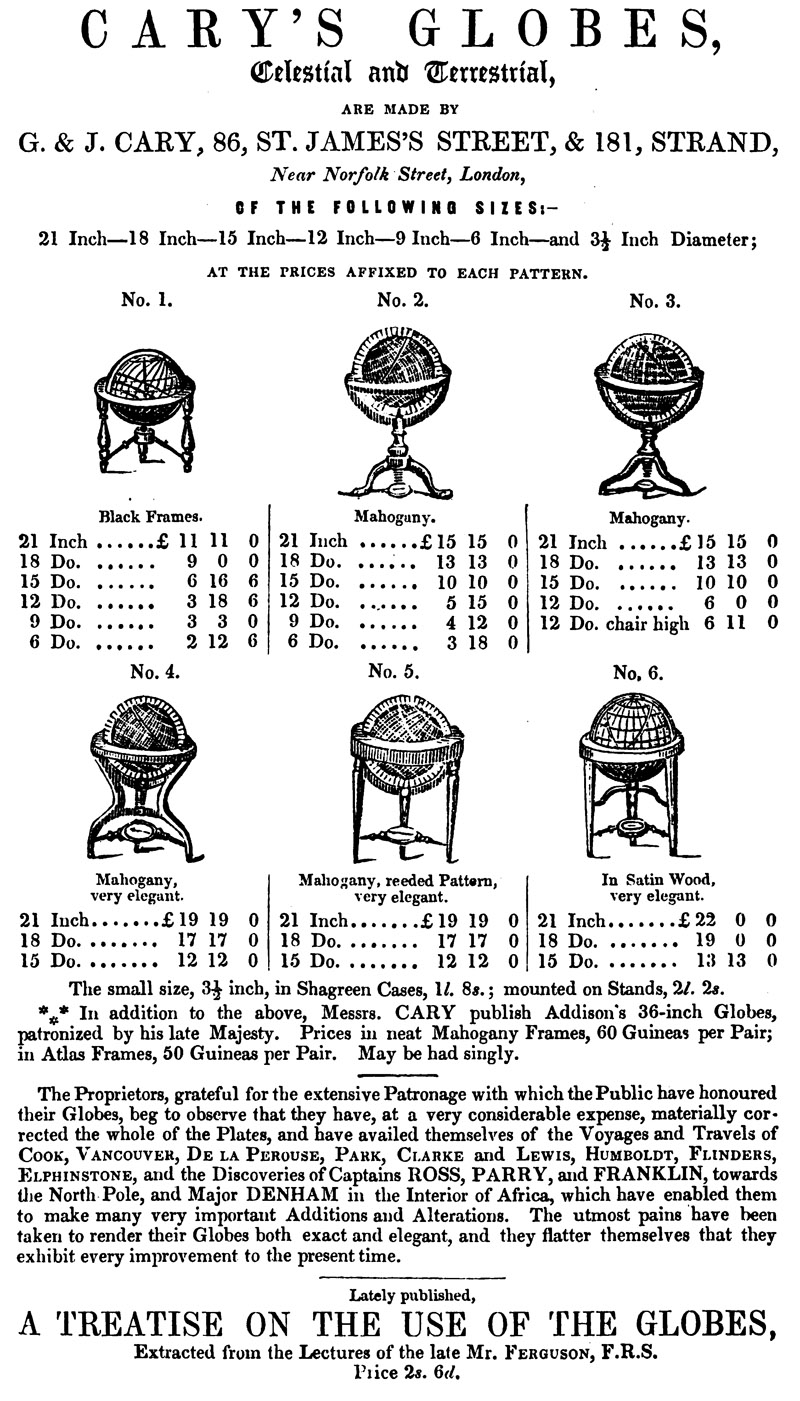
Figure 24.
An 1841 advertisement from George and John (junior)
Cary. They and their father, John, were map- and globemakers by training. It is
logical that they would have left day-to-day operations of the optical works to
experienced craftsmen and managers such as Charles and Henry Gould.
As noted above, John Cary Sr. died in 1835, leaving his businesses to sons John Jr. and George.
On March 18, 1840, Henry Gould testified in court regarding a disagreement over payment. He stated that he had been “foreman to Mr. Cary” in September, 1835. Thus, by the mid-1830s, both Charles and Henry Gould were instrumental in running the Cary operation.
The first nationwide census of Great Britain took place in 1841. From that source, we learn that 181 Strand was occupied by Charles Gould (50 years old, “Shopman”), Emma Gould (35 years old), Henry Gould (40 years old, “Shopman”), Charlotte Gould (40 years old), Emma Gould (1 year old) and Ellen Cook (25 years old). The 1841 census takers were instructed to round off people’s ages to the nearest 5 or 10 years, so the exact ages of many of the occupants are not known. Other censuses and marriage and birth records indicate that Henry and Charlotte Gould were husband and wife, and the 1 year old Emma was their daughter. The marriage record of Henry and Charlotte states that Charles was his father. Charles Gould’s 1849 death record states that he was then 63 years old, giving him a birth year of ca. 1786 and an age of 55 in 1841. The 1851 census recorded that Henry was then 55 years old, so the two censuses give him a birth year in the range of 1796 to 1801. Either some of these records are very wrong, Charles got an extremely early start at parenthood, or Charles was not Henry’s biological father. Noting that Henry named his daughter “Emma”, the elder Emma who lived at 181 Strand may have been his sister.
The two owners of business lived elsewhere. John Cary, Jr. (50 years old, “Optician”) lived with his wife, two children and three servants in Hanover Square. George Cary (50 years old, “Globemaker”) lived with two servants in St. James Square.
Charles Gould continued through the years to publish his microscopy book, although he broadened the covered topics. The 1839, 13th edition, was 70 pages long (plus an index), and entitled The Companion to the Compound, Oxy-hydrogen and Solar Microscopes made by W. Cary, 181, Strand, with a Catalogue and Description of All the New and Most Interesting Objects; the Best Method of Procuring Them, and of Preparing Vegetable Infusions to Produce Animalcules; with Plates; Together with an Account of a Simple Apparatus for Examining the Phenomena of Chemical Action, and a Description of C. Gould’s Improved Pocket Compound Microscope. The 1848 edition deleted solar microscopes but added achromatic microscopes, and included new sections on mounting objects in balsam and on the use of polarized light.
Charles Gould died on September 15, 1849, from cholera. He was reported to have been 63 years old.
The 1851 census reported that 181 Strand contained household head Henry Gould, wife Charlotte and daughter Emma, a visiting relative of Charlotte’s, plus two “servants”: Thomas Porter (age 39) and Henry Porter (age 21). Henry Porter was later to become owner of the optical business, so it is likely that both men were business employees, rather than domestic servants. At the time of the 1841 census, Henry Porter had lived in nearby Stanhope Street with an optician named Frederick Porter. Frederick was recorded as being only 9 years older than Henry, so may have been a brother. Porter’s marriage record stated that his father, James Porter, was also an optician.
When John Cary, Jr. died in 1852, his will offered his half of the optical business for sale to brother George. George’s will, written in 1858, does not mention the optician’s business or 181 Strand, indicating that he had divested his interest. It appears that Henry Gould purchased the entire business, probably concluding the transaction in 1856. The firm had continued William Cary’s tradition of publishing local meteorological records in The Gentleman’s Magazine and Historical Record, under the name of “W. Cary”. That changed with the report for July, 1856, which was submitted by “H. Gould, late W. Cary, 181 Strand”. However, the business continued to be called “Cary” through at least 1861 (Figure 26).

Figure 26.
Advertisements that indicate retention of Cary’s name even after the Goulds had acquired the business.
Henry Gould edited further editions of Charles’ book. The title of the 1853, 16th edition was modified to C. Gould’s Companion to the Compound, Achromatic, and Oxy-hydrogen Microscopes.
Henry Gould died on December 22, 1856. The January 24 - February 21, 1857 meteorological report in The Gentleman’s Magazine and Historical Record was issued from “The Royal Observatory, Greenwich”, but authorship by “H. Gould, late W. Cary” resumed with the next issue of the magazine. The practice of submitting reports under Henry’s name continued through 1868.
Around 1863, partial ownership of the business was acquired by Henry Porter. Charlotte Gould was listed as being an “optician” in the 1861 census, and so was the likely owner at that time. Charlotte and Henry styled the shop “Gould & Porter” (Figures 27 and 28). The 1861 census listed both owners families as inhabitants of 181 Strand: Charlotte and Emma Gould, and Henry Porter, his recent wife Fanny and their two infant sons. Also included were “optician’s foreman” William Stratten (age 76) and domestic servant Sarah Warren. This was the first census to list a domestic servant at 181 Strand, and probably reflects the occupants’ enhanced financial status.
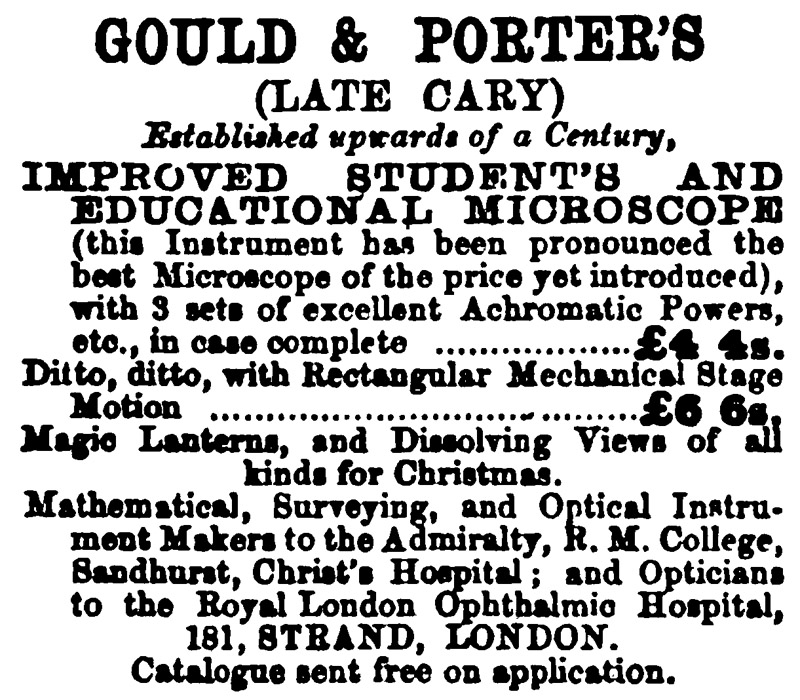
Figure 27.
An 1863 advertisement, from "The Intellectual Observer". The “upwards of a century” remark presumably refers to William Cary’s beginnings ca. 1785.

Figure 27B.
An 1872 advertisement, from "Hardwicke's Science-Gossip".
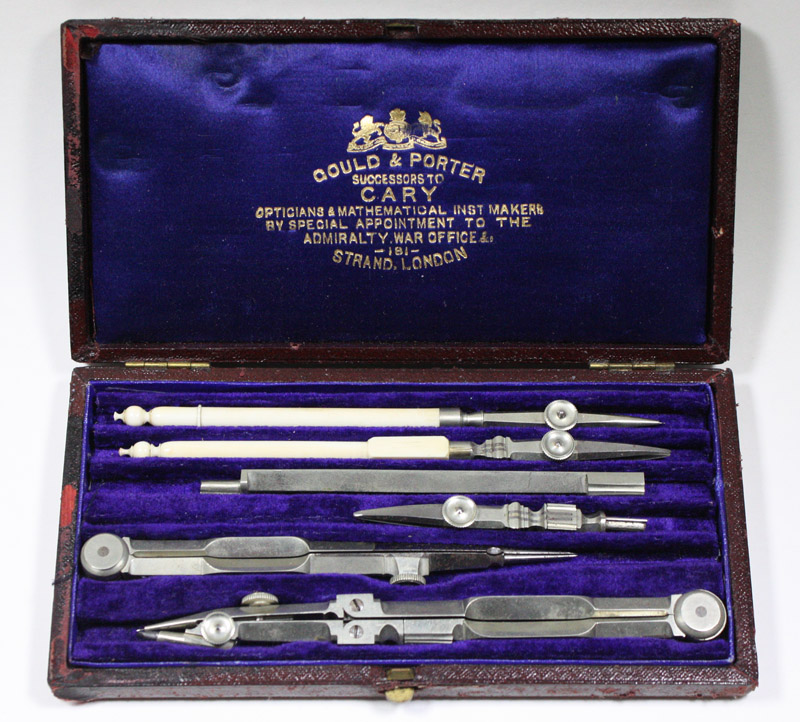
Figure 28.
A drafting set from Gould & Porter, dating from between 1863 and 1874. From the
very beginning, the Cary-Gould-Porter businesses manufactured a variety of
scientific and engineering instruments.
A comic story published in 1866 indicated that, at least for a certain class of people, the Cary optical business was well known, and that it was common knowledge that the business had recently undergone a name change. Mr. Honeybun’s Proposals: Love at First Sight in a Brompton Omnibus began with the blunt “I had just been to Cary's to have a new right eye fitted to my spectacles”, not needing to explain “Cary’s”. The protagonist, Mr. Honeybun, took a business card from the optician’s. He then met a lady on the bus, and through a series of events, ended up escorting her to her house. Nearing the home, she saw her brother approaching, and realizing that she did not know her escort’s name, asked for it. In reply, Honeybun passed her what he thought was his calling card but was, instead, the business card from the optical shop. The lady then introduced him as “Mr. Cary”. The following ensued when Honeybun asked her to stop calling him by that name, “ ‘I beg your pardon. Really I thought .. ‘ She took a card from her pocket and read, ‘Cary. No, Gould and Porter, late Cary, I see Mr. Gould – Porter – no, Gould. I’m sorry Mr. Gould, but you should allow me to call you Cary still. I told Gregory it was Cary, and it will appear so strange’ “.
Charlotte Gould died in early 1865. Nonetheless, the company continued to be called “Gould & Porter” through at least 1874 (Figure 29). Possibly, Porter could not afford to buy out Charlotte’s heirs for sole possession of the business. Henry Porter appears to have become sole owner by 1876 (Figure 30).
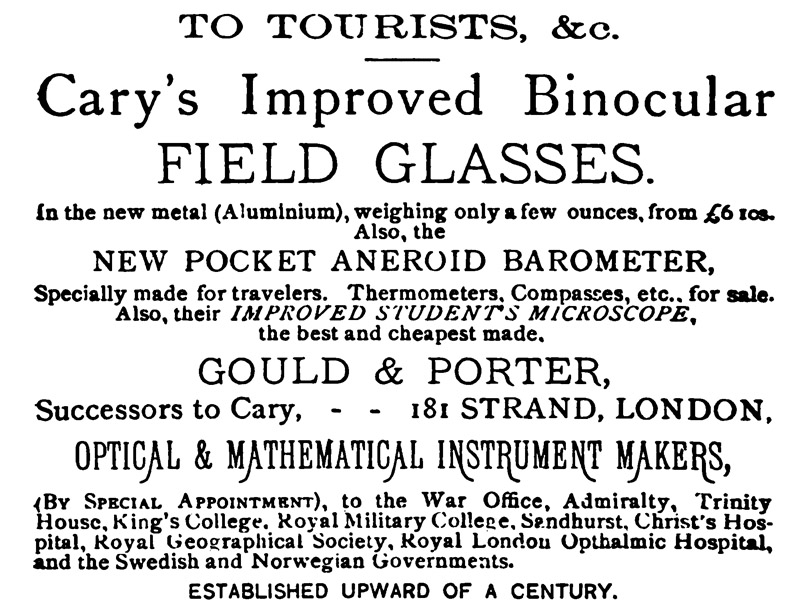
Figure 29.
An 1874 advertisement for Gould & Porter, from
Morford's Short-trip Guide to Europe. The firm continued to use the name “Gould
and Porter” even though partner Charlotte Gould had died in 1865.

Figure 30.
Henry Porter appears to have acquired sole proprietorship by the time of this 1876 advertisement. While Porter was indeed successor to William Cary, he was born several years after Cary died, and could not have actually been apprenticed to that man. However, Porter was correct in a sense, as the business was called “W. Cary” at the time he apprenticed.

Figure 31.
An 1885 advertisement.
Henry, Fanny and their six children were the only occupants of 181 Strand during the 1871 census. Coincidentally, Grace Darker, daughter of the highly-regarded scientific instrument maker William H. Darker, was a domestic servant in the chemist’s shop next door. The 1871 and 1881 censuses noted the number of people employed by businessmen. Porter’s operation appears to have been very streamlined during this period, since the 1871 census recorded that his sole employee was a messenger, and in 1881 employed his son, Sidney and one messenger. Nonetheless, the business continued to produce well-regarded instruments, as evidenced by the numerous contracts described in advertisements.
Porter moved his business to 7 Pall Mall during the 1890s. Henry died on January 18, 1902, leaving the business to sons Sydney and Clement. The company’s reputation for excellence continued, with Cary, Porter, Ltd. winning a Silver Medal at the 1904 St. Louis International Exposition. They continued to operate for several more years, supplying all manners of optical and scientific instruments (Figures 33-35). By 1921, Cary Porter had moved to 22 Charing Cross Road and Vale Terrace, Hermitage Road, Finsbury Park. Nineteenth-Century Scientific Instruments and their Makers cites a letter dated October 24, 1931 that referred to “the late firm of Cary Porter”, implying that the business had ceased to exist by that date.
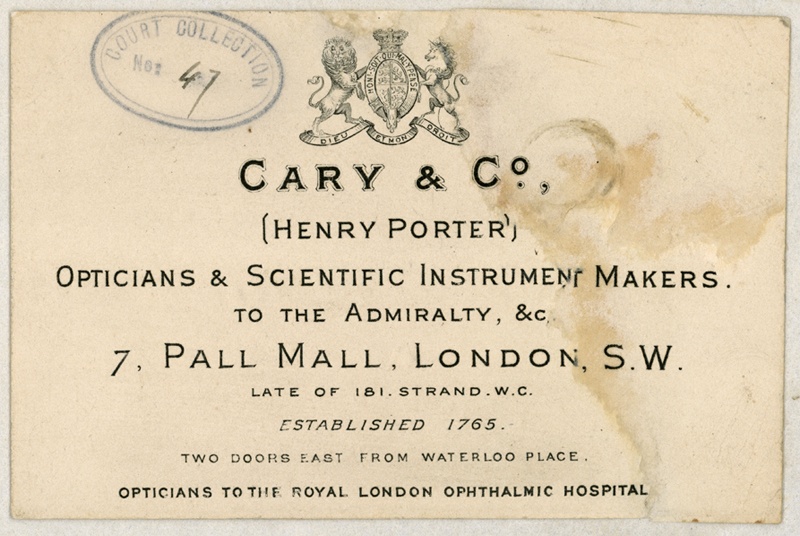
Figure 32.
A trade card from Henry Porter / Cary. The business moved from 181 Strand to 7 Pall Mall during the 1890s.

Figure 33.
A 1906 advertisement. At that time, the business was operated by Henry Porter’s sons, Sydney and Clement.
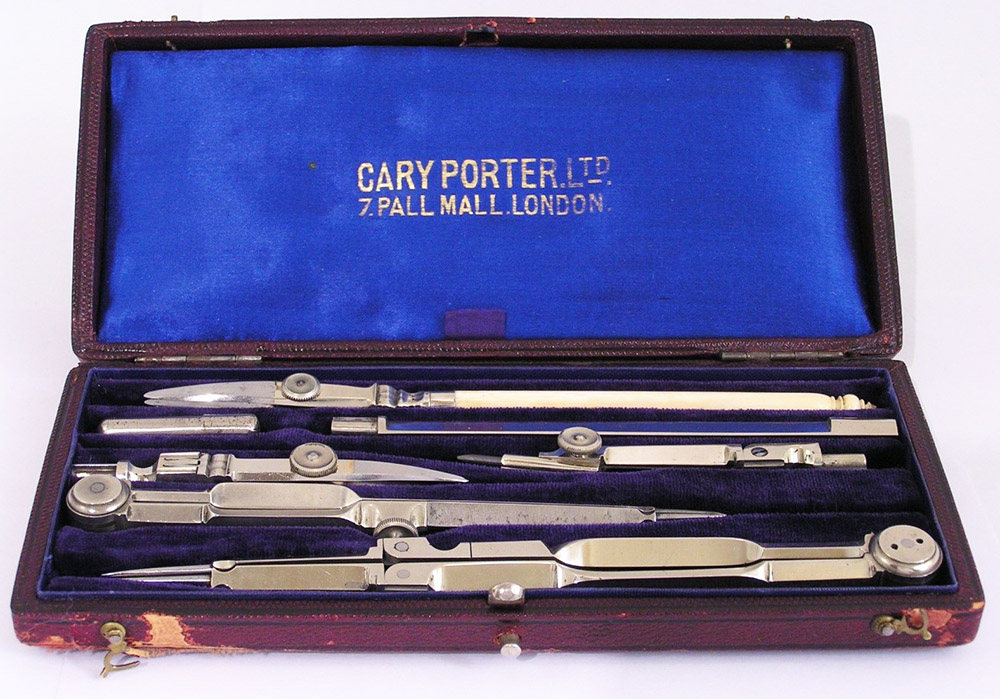
Figure 34.
Circa 1910 draughting set by Cary, Porter Ltd. Image adapted for nonprofit, educational purposes from an internet auction site.
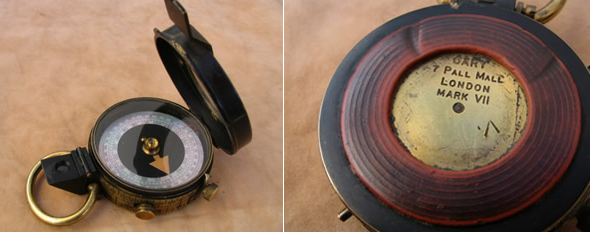
Figure 35.
Circa 1916 compass by Cary. Images adapted for nonprofit, educational purposes from an internet auction site.
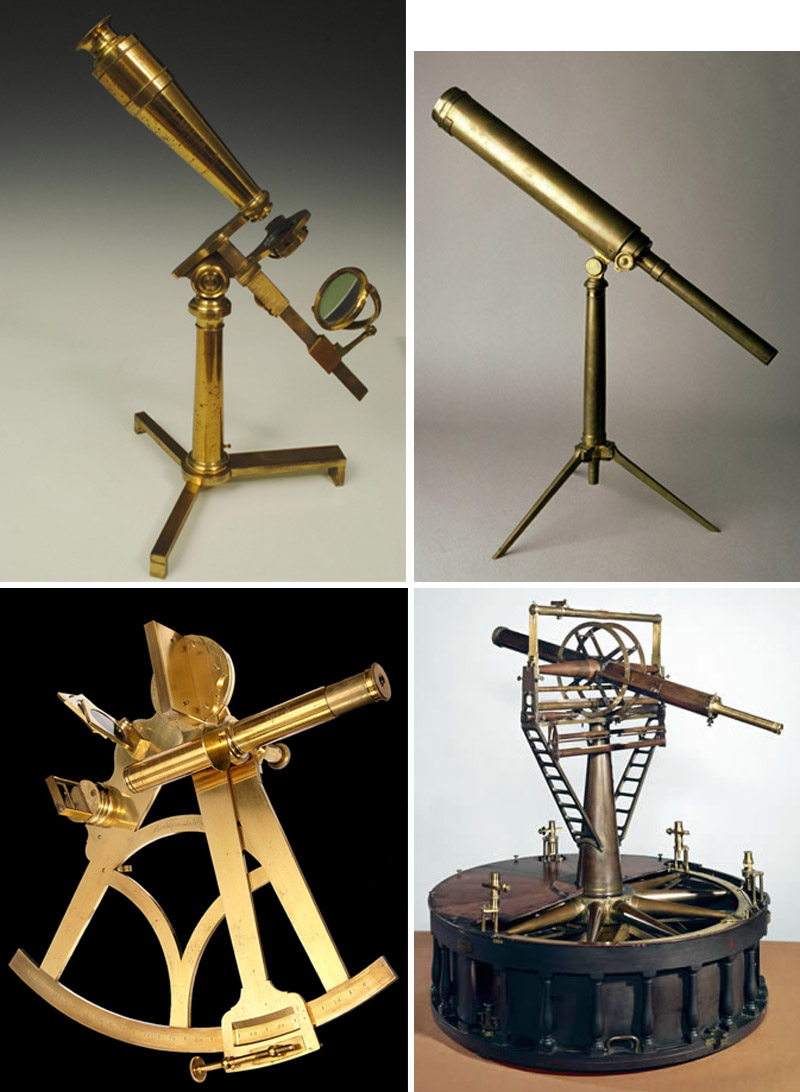
Figure 36.
Scientific apparatus produced by Jesse Ramsden, with
whom William Cary served his apprenticeship. Clockwise from upper left: microscope (from http://www.fleaglass.com/index.php?a=2&b=8143);
refracting telescope (from http://www.hps.cam.ac.uk/whipple/explore/astronomy/twotelescopes/);
theodolite (from
http://www.ramsden.info/Ramsden/Ramsdens/JesseRamsden.htm);
sextant
(from http://www.mhs.ox.ac.uk/sis25/image.php?id=45)
. Images adapted for nonprofit, educational purposes.
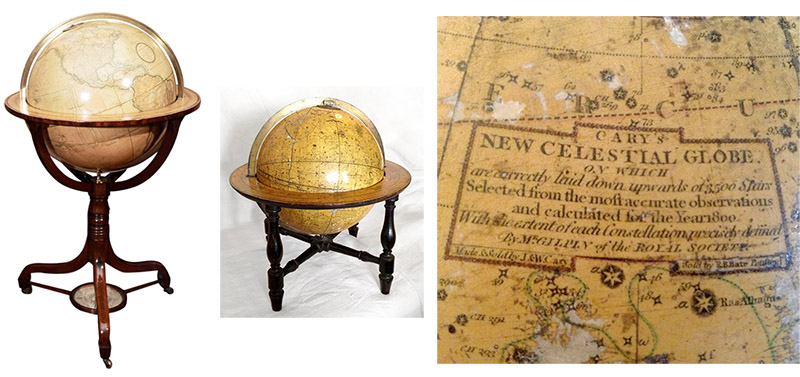
Figure 37.
Two globes made by John and William Cary. Left, a terrestrial globe, dated 1799. Center, a celestial globe, dated 1800. Right, inset on the celestial globe, indicating manufacture and sale by J. and W. Cary, and also retail by Robert Bate. Images adapted for nonprofit, educational purposes from internet auction sites.

Figure 38.
A compass made by John and William Cary, dating from the first quarter of the nineteenth century. Image adapted for nonprofit, educational purposes from an internet auction site.
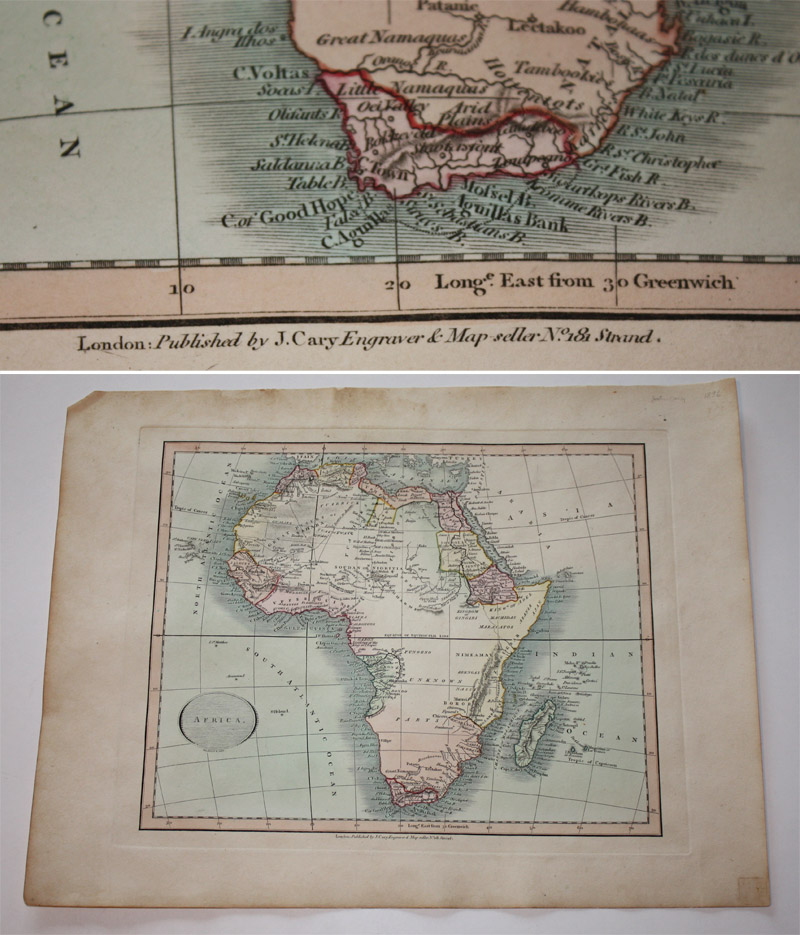
Figure 39.
Circa 1800 map of Africa, by John Cary.
Acknowledgements
My thanks to the collectors who generously contributed pictures and shared information.
Resources
The Atheneum (1833) Advertisements for the Cooper-Cary hydro-oxygen microscope, June 29, page 421 and Dec. 14 advertiser
Baptism record of Henry Porter (1832) October 24, Lambeth St. John the Baptist parish records
The Billings Microscope Collection, Second Edition (1974) Images and descriptions of Cary microscopes on pages 27-28, 38 and 185-186, with an error on page 27: “William Cary, a mathematical instrument maker, was succeeded by Charles Gould under the name of Gould and Porter”
Bland and Long (1854) Descriptive and General Catalogue of Philosophical Apparatus and Chemical Preparations, London
Carpenter, Thomas (1829) On the microscope, Gill’s Technological & Microscopic Repository, Vol. 5, pages 65-72
Cary, William (1803) Meteorological tables for Oct. 1803, Gentleman’s Magazine, page 2 (and many other issues of this magazine)
Cary, William (1811) Description of the patent reflecting semicircle, invented by Sir Howard Douglas, Bart., The Philosophical Magazine, Vol. 38, pages 186-187
Cooper, Daniel (1842) A brief sketch of the rise and progress of microscopic science, and the principal means enumerated which have tended to its general advancement, Microscopic Journal and Structural Record, Vol. 2, pages 1-4
Death record of Charles Gould (1849)
Dictionary of National Biography (1887) “William Cary”, edited by L. Stephen, Vol. 9, Macmillan and Co., New York, page 253
England censuses and other vital statistics, accessed through ancestry.co.uk
Fordham, Herbert George (1914) Studies in Carto-bibliography, Clarendon, Oxford, page 84
Fordham, Herbert George (1925) John Cary, Engraver, Map, Chart and Print-Seller and Globemaker 1754 to 1835, University Press, Cambridge
Gill, Thomas (1828) On an improved apparatus or slider for viewing the animalcules in water under the microscope, Gill’s Technological & Microscopic Repository, Vol. 2, pages 262-263
Gill, Thomas (1829) Mr. Gould's adjusting stage for the Microscope, Gill’s Technological & Microscopic Repository, Vol. 3, pages 147-148
Gill, Thomas (1829) On Mr. Gould's microscopic lenses, of high powers, Gill’s Technological & Microscopic Repository, Vol. 3, page 149
Gill, Thomas (1829) On Mr. Holland's new method of mounting transparent objects preserved in spirit of wine, for the microscope, Gill’s Technological & Microscopic Repository, Vol. 3, pages 196-197
Gill, Thomas (1829) Mr. C. Gould's slider for viewing animalcules in water, Gill’s Technological & Microscopic Repository, Vol. 3, pages 197-198
Gill, Thomas (1829) The Editor's pond or shallow cistern for viewing animalcules, &c. in water, Gill’s Technological & Microscopic Repository, Vol. 3, page 198
Gill, Thomas (1829) On Mr. Holland's new method of mounting transparent objects, preserved in spirit of wine, constantly ready for viewing in the microscope, Gill’s Technological & Microscopic Repository, Vol. 3, page 321
Gill, Thomas (1830) The late Dr. Wollaston's microscopic doublet, Gill’s Technological & Microscopic Repository, Vol. 6, pages 313-314
Gill, Thomas (1830) Mr. C. Gould's mode of mounting microscopic objects, to be viewed under highly magnifying powers, Gill’s Technological & Microscopic Repository, Vol. 6, pages 314-315
Gould, Charles (1829) The Companion to the Microscope, Edition 6, W. Cary, London
Gould, Charles (1839) The Companion to the Compound, Oxy-hydrogen and Solar Microscopes made by W. Cary, 181, Strand, with a Catalogue and Description of All the New and Most Interesting Objects; the Best Method of Procuring Them, and of Preparing Vegetable Infusions to Produce Animalcules; with Plates; Together with an Account of a Simple Apparatus for Examining the Phenomena of Chemical Action, and a Description of C. Gould’s Improved Pocket Compound Microscope, Edition 13, Simpkin and Marshall, London
Gould, Charles (1848) The Companion to the Compound, Achromatic, and Oxy-hydrogen Microscopes made by W. Cary, 181, Strand, with a Catalogue and Description of All the New and Most Interesting Objects; the Best Method of Procuring and Mounting Them in Canada Balsam, for the Microscope; and of Preparing Vegetable Infusions to Produce Animalcules; with Plates; Together with an Account of a Simple Apparatus for Examining the Phenomena of Chemical Action, and Polarized Light, Under the Microscope; and a List of All the Most Popular Objects that Polarize, Edition 15, S. Highley, London. Title and publication information only, obtained through GoogleBooks
Gould, Charles and Henry Gould (1853) C. Gould’s Companion to the Compound, Achromatic, and Oxy-hydrogen Microscopes, Edition 16, S. Highley, London. Title and publication information only, obtained through GoogleBooks
Hardwicke's Science-Gossip (1872) Advertisement from Gould and Porter, Vol. 8, page ii
A Handbook for Travellers in Greece (1876) Advertisement from H. Porter, J. Murray, London, page 46
Hewitson, John (1847) A Condensed Catalogue of Optical, Mathematical, and Philosophical Instruments and Apparatus, 6 pages, attached as advertisement to J. Ewart, Instructions for the Use of the Slide-Rule, Hewitson, Newcastle-on-Tyne
Intellectual Observer (1863) Advertisements from Gould & Porter, Vol. 4
Journal of the Chemical Society (1900) Report of the Annual General Meeting, included this statement: “In the early part of the century, the price of manufactured platinum was less than half its present value. In 1805, platinum crucibles were to be obtained from Mr. Carey, 182, Strand, at 17s 6d. the ounce, whilst wire was 16s”, Vol. 77, page 578
Journal of the Society of Arts (1885) Advertisement from H. Porter, February 20 issue
Kent’s Directory for the Year 1794, Cities of London and Westminster, & Borough of Southwark (1794) accessed through http://www.londonancestor.com/kents/kents-c.htm
Kent’s Original London Directory (1822) “Cary, George, haberdasher, 63, Strand, .. , Cary John, optician, 182, Strand, .., Cary John, engraver & mapseller, 86, St. James's-street, Cary Wm. optician, 277, Strand”, page 64
The Literary Gazette (1829) Advertisement for C. Gould’s Improved Lucernal Microscope, Vol. 13, page 607
The London Mechanics’ Register (1826) Mr. C. Gould’s patent portable compound microscope, Saturday, June 10, pages 97-98
The London Miscellany (1866) Mr. Honeybun’s proposals: A serious story for maids, wives, and widows, young married men and very old bachelors, Proposal No. 1 – Love at first sight in a Brompton omnibus, Vol. 1, pages 121-123
Marriage record of Henry Gould and Charlotte Hyde (1839) St. Clement Danes parish records
Marriage record of Henry Porter and Fanny Rorke (1859) St. Dunstan in the West parish records
microscope-antiques.com (accessed January, 2014) information on Charles Gould’s small, box-mounted microscopes, http://www.microscope-antiques.com/carysmall.html
microscope-antiques.com (accessed January, 2014) information on early test slides produced by Cary, http://www.microscope-antiques.com/carytestobjects.html
microscope-antiques.com (accessed January, 2014) history of Charles Gould’s Companion to the Microscope books, http://www.microscope-antiques.com/gouldsbooks.html
Morford, Henry (1874) Morford’s Short-Trip Guide to Europe, Lee, Shepard and Dillingham, New York, includes an advertisement from Gould & Porter
Murray's Handbook Advertiser (1857) Advertisement from Cary, page 27
Murray's Handbook Advertiser (1861) Advertisement from Cary, May issue, page 7
New Monthly Magazine (1825) “Died: Mr. William Cary, of the Strand”, Vol. 40, page 560
Notcutt, William L. (1859) A Handbook of the Microscope and Microscopic Objects, E. Lumley, London, page 27
Palmer, Edward (1840) Palmer’s New Catalogue
The Photographic Dealer (1898) Application for trademark: Spectacles and eyeglasses and ophthalmic appliances in class 8. Henry Porter, trading as Cary & Co., 7 Pall Mall, London, S.W. Mathematical Instrument Maker and Optician. 26 April 1898, page 19
Pike, Benjamin (1848) Pike’s Illustrated Descriptive Catalogue of Optical, Mathematical, and Philosophical Instruments, Vol. 2, New York
Post Office Annual Directory, London (1808) “Cary George, Haberdasher, 63, Strand, Cary John, Map & Printseller, 181, Strand, Cary William, Optician, 182, Strand”, page 54
Pritchard, Andrew (1847) Microscopic Objects, Whittaker and Co., London, pages 142-147
Probate of Henry Gould (1860) accessed through ancestry.co.uk
Probate of Henry Porter (1902) accessed through ancestry.co.uk
The Quarterly Literary Advertiser (1841) advertisements from G. and J. Cary
Quekett, John (1848) Practical Treatise on the use of the Microscope, H. Balliere, London, pages 289-290
Reeves, E.A. (1906) Hints to Travellers Scientific and General, Royal Geographical Society, London, includes an advertisement from Cary, Porter, Ltd.
Report of His Majesty's Commissioners for the International Exhibition, St. Louis (1904) “Cary, Porter, Ltd… were awarded a Silver Medal”, page 237
Report of the Trial of the Cause Carew against Burrell, Bt., and Another (1840) page 88, accessed through http://books.google.com/books?id=vnsDAAAAQAAJ&pg=PA88&dq=%22henry+gould%22+strand#PPP5,M1
Royal Geographical Society Year-book and Record (1898) List of members: Porter, Henry, Esq. 7, Pall-mall, S.W. (since 1877), page 150
Stimson, A.N. (1984) Some board of longitude instruments in the nineteenth century, reference 28, “A manuscript by Angus Thirl dated 24 October 1931 ‘Up to a few years ago there was a dividing engine at the works of the late firm of Cary Porter, with the name Stanforth (sic) and date 1791, this man like William Cary…was an apprentice of Ramsdens’ ”, in Peter R. De Clercq, Peter R. (editor) Nineteenth-Century Scientific Instruments and their Makers: Papers Presented at the Fourth Scientific Instrument Symposium, Amsterdam, 23-26 October 1984, Museum Boerhaave, Leiden
The Tourist, or Sketchbook of the Times (1833) Microscopic view of a drop of water, Vol. 1, pages 175-176
Traill, Thomas S. (1828) Thermometer and Pyrometer, includes an advertisement for C. Gould’s New Improved Pocket Compound Microscope
Transactions of the Society, Instituted at London for the Encouragement of Arts, Manufactures and Commerce (1837) Contributing members: Gould, Mr. Charles, 181 Strand, Vol. 52, page ix
Turner, Gerard L.’E. (1989) The Great Age of the Microscope, Adam Hilger, Bristol, pages 7, 65-66, 75-85, 92 and 239-240
Wollaston, William H. (1829) A description of a microscopic doublet, Philosophical Transactions of the Royal Society of London, pages 9-13
The Young Mechanic (1833) Beautiful experiments on the hydro-oxygen microscope (reprinted from the London Times) Vol. 2, pages 115-116